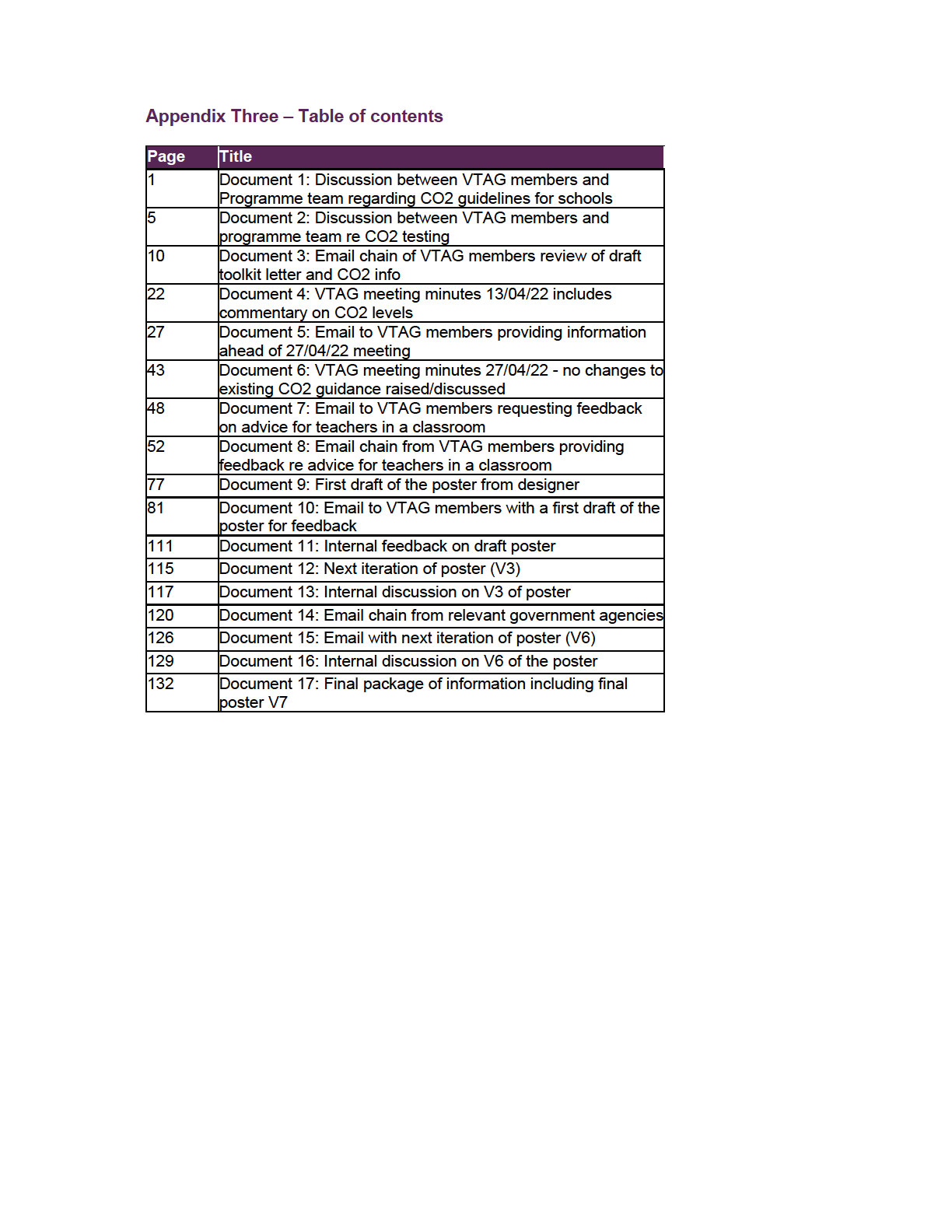
1982
Act
Information
Official
the
under
Released
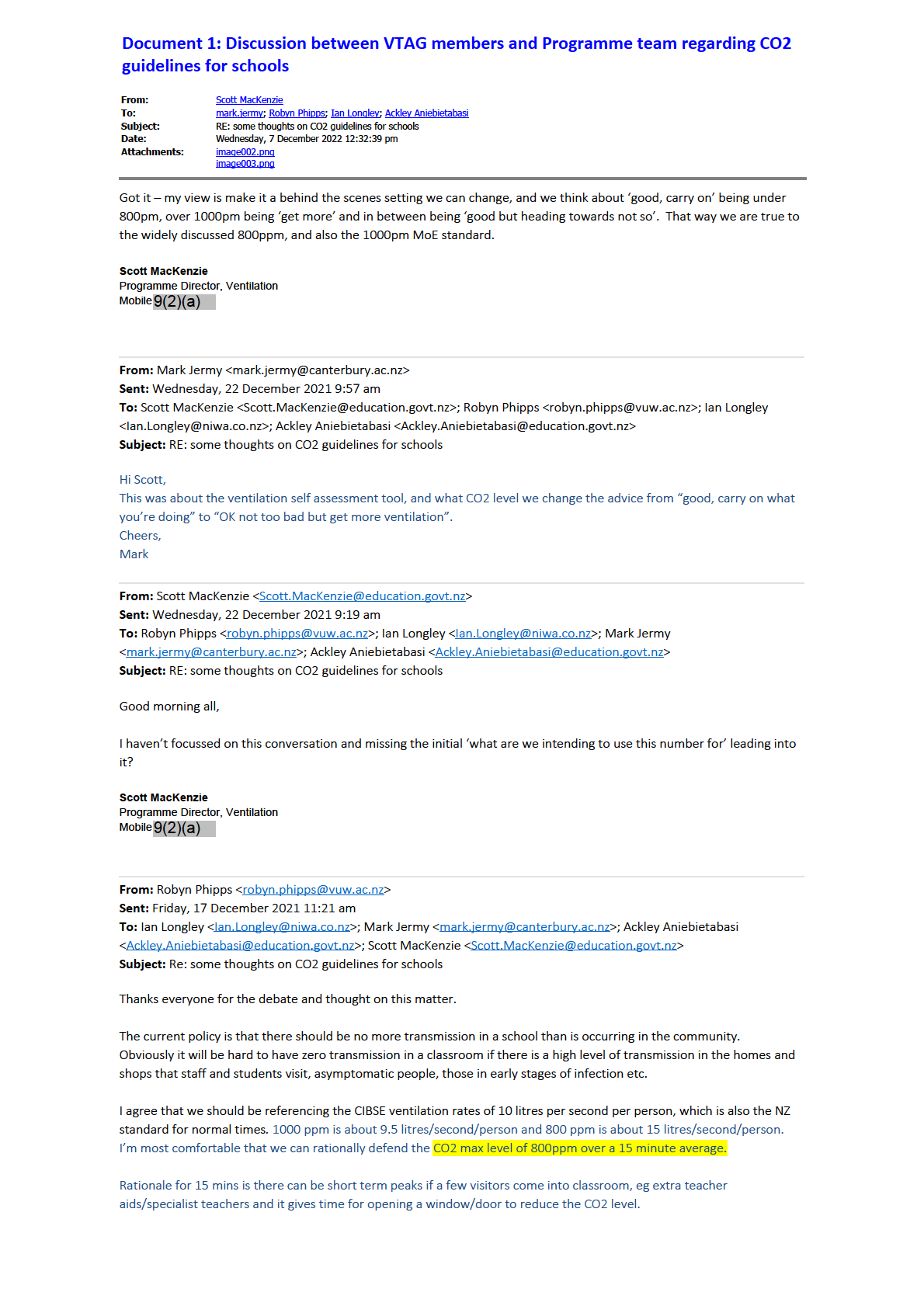
1982
Act
Information
Official
the
under
Released
Regards
Robyn
From: Ian Longley <[email address]>
Date: Friday, 17 December 2021 at 10:06 AM
To: Mark Jermy <[email address]>, Ackley Aniebietabasi <[email address]>,
Robyn Phipps <[email address]>, Scott MacKenzie <[email address]>
Subject: RE: some thoughts on CO2 guidelines for schools
1982
A more philosophical issue is what are we trying to achieve? Zero transmission in schools is one objective, in which case
I’d go for 800 (or even lower). By going for 1000 I’d say we’re signalling that that is not our objective. Our national switch
from elimination to suppression of COVID-19 would imply zero transmission is not our goal. However, I’d argue that’s
specific to COVID-19 delta variant.
Act
More generally, these are public health and political issues. 9(2)(g)(i)
Ian
From: Mark Jermy <[email address]>
Sent: Thursday, 16 December 2021 3:45 PM
To: Ackley Aniebietabasi <[email address]>; Ian Longley <[email address]>; Robyn Phipps
Information
<[email address]>; Scott MacKenzie <[email address]>
Subject: RE: some thoughts on CO2 guidelines for schools
Hello all,
Excellent points from Ackley and Ian.
My 2 cents worth:
Official
1. Calculating the percentage risk a student has, over a school day, is very difficult. It requires data on the viral load of
the infectious person and the susceptibility of others in the class. These are not well known for Delta for adults, and
are even more uncertain for children, or for Omicron, and are of course unknown for the next variant of concern.
the
Instead, I prefer a ratio approach: what is the risk to student A (who is sitting far from the infectious case)
compared to student B (who is sitting right next to the infectious case, thus their risk is not strongly affected by
ventilation).
2. If we want this ratio to be 1/10 (student A has 1/10th the risk of student B) then for a typical 190 m3 classroom
with 31 people, we need 5.3 ACH and 1000 ppm CO2 (assuming no air filtration)
If we want this ratio to be 1/15, we need 8.3 ACH and 800 ppm CO2
under
Personally I am happy with 1/10 instead of 1/15, as student A has other opportunities for close contact with the
infectious case outside this classroom, and children don’t catch COVID-19 easily, etc... however that decision is for
others to take, it’s outside my lane!
3. ASHRAE recommend, for hospitals, 4-6 ACH for patient rooms, and 6 ACH for examination and treatment rooms,
with at least 2 ACH being fresh air (the rest can be recirculated). That’s a high standard. By achieving 5 ACH, in a
school where we expect fewer highly vulnerable people compared to a hospital, we’re already choosing a high
safety level
4. CIBSE note that ventilation rates of 10 litres per second per person or less are recommended by a number of
official bodies for health and comfort in normal times
. 1000 ppm is about 9.5 litres/second/person and 800 ppm is
Released
about 15 litres/second/person.
Therefore 1000 ppm meets the ASHRAE recommendation for hospitals and the 10 L/s/person target, and meets my
arbitrary 1/10th risk ratio.
Another consideration is that setting a threshold at 800 ppm will result in more rooms being identified as needing
investigation and remediation. 1000 ppm will keep this list shorter, leaving off the less urgent spaces.
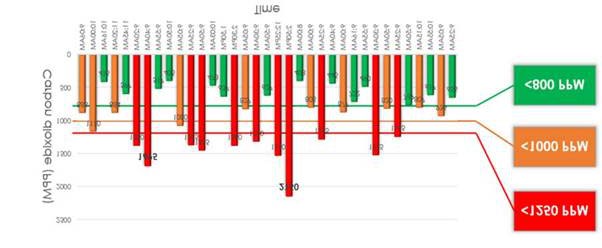

Against that, 800 ppm is commonly used elsewhere and is the default green/orange threshold for many CO2 monitors.
There is value in using the same number consistently in all communications.
Cheers,
Mark
From: Ackley Aniebietabasi <[email address]>
Sent: Thursday, 16 December 2021 12:12 pm
To: Ian Longley <[email address]>; Robyn Phipps <[email address]>; Mark Jermy
<[email address]>; Scott MacKenzie <[email address]>
Subject: RE: some thoughts on CO2 guidelines for schools
Thanks Ian and Mark,
1982
I agree with the practical cases you’ve listed below, which is consistent with our previous CO2 measurements in schools,
but I’m inclined to suggest that we consider an average of 800 ppm to ensure the extra ventilation needed to prevent
Act
transmission, and for consistency with some of the international recommendations.
Thinking about ACH, my understanding from Mark’s explanation at the meeting yesterday was that 1000 ppm is about
5.2 ACH, and ideally, our target is for 6 ACH. So, the question that comes on my mind is: What is the ACH and
background ventilation rate (l/s/person) for 800 ppm, and what does it equate to in a % risk of infection?
In a typical Avalon classroom in Wellington, we provided a traffic light CO2 monitor, where I set the CO2 thresholds
shown in the bar chart below. In the first phase of the experiment, we provided a pre-designed template and asked the
students/teachers to record the CO2 levels based on the green, orange and red peeps.
After two weeks, we went to the school and discussed the results with the students and their class teacher. As reported
by Newsroom, “the students identified that often carbon dioxide levels on the electronic monitoring device we provided
increased quickly when the windows were closed, but as they opened the windows the levels decreased significantly. The
students found it difficult to persuade a relief teacher to keep the windows open on a cold winter day”.
Information
This suggested an awareness of what to do when CO2 levels are above the recommended threshold helped to promote
environmental competency (reflecting on our discussion with Chris on Tues).
Official
the
My thoughts are that we should consider a target that will provide the good ACH, background ventilation rate, which will
potentially reduce the risk of infection, and consider consistency with international recommendations and our
forthcoming on-demand DQLS CO
under 2 target.
Happy to discuss further.
Nāku noa, nā
Ackley
Aniebietabasi Ackley (Jnr), PhD | Senior Technical Advisor | TPHM School Design Team
TPHM-Te Puna Hanganga, Matihiko | Infrastructure & Digital
https://nz.linkedin.com/in/ackley-aniebietabasi-2b361a85
DDI +6444637590
Released
National Office Mātauranga House
education.govt.nz
We shape an education system that delivers equitable and excellent outcomes
He mea tārai e mātou te mātauranga kia rangatira ai, kia mana taurite ai ōna huanga
 From:
From: Ian Longley <[email address]>
Sent: Wednesday, 15 December 2021 7:46 PM
To: Robyn Phipps <[email address]>; Mark Jermy <[email address]>; Ackley Aniebietabasi
<[email address]>; Scott MacKenzie <[email address]>
Subject: some thoughts on CO2 guidelines for schools
In principle I’m happy with a 1000 ppm guideline, which I make to roughly equate to a 1% risk of infection over 1 hour
(based on numerous assumptions).
I’m mainly concerned about the practical application/implications.
Firstly, I would clarify that this is a
instantaneous guideline, which in practice should be interpreted as CO2 should not
stay over 1000 ppm for at least 5 minutes (or instruments providing running 5-minute averages are fine), followed by
1982
immediate
behavioural action if it does and
training/
infrastructural intervention if it happens persistently over
days/weeks.
Act
In practical cases, and looking at our study data, most of our classrooms fall into three categories:
1. Under-occupied or well-ventilated – never get close to 1000
2. Under-ventilated but vacated after within the hour – these tend to get to around 1200 ppm (if normally occupied)
by the end of the period
3. Under-ventilated and occupied for > 1 hour (or insufficiently flushed between classes) – these get well over 1200
and over 2000 in many cases
Let’s imagine for now we have a visual traffic light indicator which is only either green or red either side of 1000 ppm.
Type 1 are obviously fine.
Information
Type 2 tend to go over 1000 ppm only towards the last half, and maybe even the last 10 minutes of the period. Generally
small modifications (1 or 2 extra window openings) are likely to bring CO2 down below 1000. We’d like to hope that after
this happening multiple times the teacher will get the gist and open that extra window earlier to pre-empt the monitor
going red in which case – job done (depending on how many teachers use the room).
Type 3 are the really problematic ones, but note that there are three interventions:
Significantly increase ACH (not an option in winter)
Official
Schedule a “flush” after an hour
Don’t timetable rooms to be used continuously for more than an hour
Note that emptying the classroom for 5 minutes has very limited effect without the flush and the flush is still effective if
everyone stays put. The question is – is a 5 minute flush practical?
the
It may also be worth bearing in mind (and maybe communicating) the non-linear relationship between CO2 and infection
risk:
The longer a room is occupied the more likely CO2 is to level off and stop rising (except in really poorly ventilated
cases)
Infection risk does THE OPPOSITE – growing exponentially with time. Another reason why double-periods without
under
mid-period mitigation might be the biggest risk in schools.
Hope that helps!
Ian
Dr Ian Longley
Principal Scientist - Air Quality
Programme Leader - Atmospheric Environment, Health and Society
Released
9(2)(a)
National Institute of Water & Atmospheric Research Ltd (NIWA)
41 Market Place Viaduct Harbour Auckland New Zealand
Connect with NIWA: niwa.co.nz Facebook LinkedIn Twitter Instagram
To ensure compliance with legal requirements and to maintain cyber security standards, NIWA's IT systems are subject to ongoing monitoring, activity logging and
auditing. This monitoring and auditing service may be provided by third parties. Such third parties can access information transmitted to, processed by and stored on
NIWA's IT systems
Document 2: Discussion between VTAG members and programme team re CO2 testing
F om
Ma k Je my
To
Ian ongley Sco t MacKenz e Scott MacKenz e Robyn h pps
Cc
Jeff W lson V cky Evans Jason Chen Ackley Aniebie abasi Renelle G one t
Subject
RE nal Results Home Test Set #11 - whe e it takes us next
Date
day 7 Janua y 2022 8 18 09 pm
A tachments
mage008 png
mage010 png
mage012 png
mage014 png
mage016 png
mage018 png
mage020 png
mage023 png
mage024 png
mage025 png
mage026 png
Hi a l,
A couple of points n case they a e of use
1) Scott, if you need a efe ence fo 10 l/s/pe son and 6 ACH, he e s a passage w th efe ences
“Vent lat on ates of 10 l t es pe second pe pe son a e ecommended fo health and comfo t n no mal t mes by a numbe of sou ces [3] The h ghe the vent lat on ate the lowe the nfect on sk
Fo hosp tals ASHRAE ecommends 4-6 a changes pe hou (ACH) fo pat ent ooms 6 ACH fo exam nat on and t eatment ooms and 12 fo a bo ne nfect on solat on ooms w th at least 2 ACH be ng f esh outdoo a n each case and the est may be ec culated f clean [4]
A l t es-pe -second ta get depends on the numbe of people n the oom and a -changes-pe -hou ta get does not We ecommend both types of ta get a e ach eved f poss ble
[3] C BSE Gu de B Heat ng Vent lat ng A Cond t on ng and Ref ge at on (2016)
[4] ASHRAE Standa d 170-2021 -- Vent lat on of Health Ca e Fac l t es (Ame can Soc ety of Heat ng Ref ge at on and A -Cond t on ng Eng nee s)”
We also have a ationale fo 5.3 ACH. At this ai change ate, afte 1 hou , a suscept ble pe son n the same oom, but fa enough f om the nfectious case that the ai they b eathe is well mixed, eceives a dose of vi us which s less than 1/10th the dose fo a pe son s tting bes de the infect ous case.
(We assume the pe son sitting next to the infect ous case is 1 met e away and facing the same way).
2) If we a e to compa e pu ging with constant vent lat on, I th nk the isk of t ansm ssion of COVID is best assessed by the total dose of vi us eceived while spend ng a given pe iod in the oom. The efo e we could compa e the effectiveness of pu ging vs. the effect veness of constant vent lat on by the level of PM (o CO2) integ ated ove a
given pe iod of time (say a 1h lesson). It should be easy to calculate this fo set ai change ates, I ll have a go.
3) I think the p io ty fo Jason and I is to complete the calculat on algo ithm fo the self assessment tool (we ll include w nd d iven flow) and then un it fo a ep esentative set of class ooms fo diffe ent times of yea in diffe ent cl mates.
Chee s,
1982
Ma k
From Ian Longley Ian.Longley@niwa co.nz>
Sent F iday, 7 Janua y 2022 3 46 pm
To Scott MacKenz e Scott@sapius nz> Scott MacKenzie [email address]> Robyn Phipps obyn ph [email address]> Ma k Je my ma k je my@cante bu y ac.nz>
Cc Jeff Wilson [email address]> V cky Evans V cky Evans@education govt.nz> Jason Chen jason.chen@cante bu y.ac.nz> Ackley Aniebietabasi ackley.aniebietabas @education.govt.nz> Renelle G one t Rene le G one [email address] nz>
Sub ect RE Final Results Home Test Set #11 - whe e it takes us next
Hi Scott
Act
Ag ee with all of that, I think. I like the idea of ai cleane s be ng used tempo a ily wh le mo e pe manent building modifications a e made (if you have enough), but also awa e a cleane allocation/p io it sation p ocess w ll be equi ed.
Rega d ng ongoing studies and evidence to pin ecommendat ons upon, I see it like th s .
1. Solid and easily nte p eted evidence that
a. c ossflow MUCH mo e effective fo CO2 and PM
b. egula pu ge 2nd best method
c. single o mino openings not sufficient and should not be elied upon
d. ai cleane s (filt ation) effective supplement so long as x, y, z
e. (could do ANVS again)
f. I think these can be add essed elatively quickly (one week) at Epuni (o s mila ) w th some methodological imp ovements wh ch I can elabo ate on anothe time
2. good p actice fo
a. c ossflow (what methods a e eliable/va able, influence of weathe )
b. ai cleane s (speed sett ng, noise acceptabil ty, placement)
c. these nvolve a longe set of epeated obse vations ove a longe timef ame, p obably best done if the p ocess can be at least pa tly automated ( emote cont o led) so that school s v s ted only an hou /day (fo example).
3. Implementation – can teache s/schools follow inst uctions?
a. G ven Leeds expe ience that the answe will be NO unless this is ca efu ly conside ed
And f nally, my egula equest that any CO2 data s captu ed and sto ed, along with metadata, acco d ng to standa d p otocols whe eve poss ble to max mise lea n ng. Mikael, myself and othe s have long been keen on an “Indoo Ai Quality Obse vato y” that would p ovide th s cent alisation/standa disation to multiple secto s and now seems an
exce lent time to explo e that idea fu the .
Ian
From Scott MacKenzie Scott@sap us.nz>
Sent F iday, 7 Janua y 2022 10 58 AM
To Ian Longley Ian.Longley@n wa.co.nz> Scott MacKenz e [email address] nz> Robyn Ph pps obyn [email address]> Ma k Je my ma k je my@cante bu y.ac.nz>
Cc Jeff Wilson [email address]> V cky Evans V cky Evans@education govt.nz> Jason Chen jason.chen@cante bu y.ac.nz> Ackley Aniebietabasi ackley.aniebietabas @education.govt.nz> Rene le G one t Renelle.G one [email address]>
Sub ect RE Final Results Home Test Set #11 - whe e it takes us next
Love it! G abb ng back the talk ng stick noting Robyn s emails as I m typing this type of content fo the pape . Really app ec ate the spit balling, I find it the best way to a ve at sma t and quick gold nuggets.
Information
10 lps good efe ence point gives ts elevance and p ominence in bu ld ng pe fo mance (Jeff and Ma k – nudges) and maybe something ou TAG should fo m a solid view/statement on? 6ACH al eady common ef point fo the sta t of good ventilation vs 2.5-3.5 being adequate in schools (but maybe less so in this n a chang ng wo ld).
P og amme pos tioned as COVID esponse to seg egate its aims away f om cu ent DQLS, so we can leave that be fo now noting we a e a cu ent “ ” guidel ne due to COVID but what we lea n/do eventua ly folds into DQLS – so think we ve cove ed that angle.
Risk-based ta gets needs to app eciate if we a e at g een/o ange/ ed, then down to if we have infect on at this pa ticula school, what cont ols a e in fo ce (distanc ng, coho t ng, masks etc) and also the isk inhe ent n the occupant (age, medical cond tions, vac status, he d immunity etc). We can neve know if the e a e no infected people.
Good topic fo the wide esponse wo k within the M nist y to be tasked with and consult us on – I can seek th s inte na ly as an INPUT to ou th nking. V cky something we could pick up with Helen s team.
Ag ee that 800PPM is an a bit a y numbe – eads as such on CDC – you could say with Omic on it now should be lowe , o you could say it now matte s less because it s so t ansmiss ble you w ll need 12 ACH to sta t making a diffe ence – which wi l neve be an option fo schools unless we make them [new] hospitals.
Really like this type of simpl c ty f om Ian below (though Ackley wi l have thoughts – think I am eflecting discuss on late last yea on 800-1000PPM, we can cement t in at the ght time
If you can meet 800-1000 ppm consistently – you e fine in te ms of needing to focus on ventilation-specific st ateg es to minim se COVID-19 ai bo ne t ansmission.
If you can stay unde 800-1000 ppm by us ng hou ly o nte -pe iod pu ges – please do. And let s conside ecommending th s as a do anyway st ategy ega dless of ventilation pe fo mance – especially fo high schools who al eady have inte -pe od b eaks (noting coho t management needed alongside)?
If you go consistently ove 800-1000 ppm eve y pe iod – imp ove natu al ventilation until you don t. Conside changing go cons stently ove to on ave age go ove so it s measu able? Th s is why we need the class oom study esults a e c it cal – th s is l kely a REALLY BIG piece of wo k to get schools, and my bed oom to this level.
If you can t – now go to f lt at on (which may be temp while othe imp ovements a e sought o pe manent, and noting that the effect of filt ation will NOT be eflected n CO2 data). Yes on that bas s that we have ev dence that lowe ing CO2 also lowe s PM – which NIWA study does not have good data on, but my bed oom test
nd cates it does.
AND the e will be specific s tuations whe e due to sk p ofile you go to filt at on anyway [Fictitious] a school of 1000 ncludes 50 yea 6-7 k ds deemed high sk due to vac status and p e-existing health condit ons, who have class oom with max of 15, 3m desk spacing, assisted ventilation AND in oom filt ation. Seen something like
this in the US. That would be an ope at onal management decision suppo ted by ventilation advice.
So should in ou action plan clea ly include
Studies (part of GUIDE workstream)
A follow-up cont ol oom study at Epuni whe e we apply the incense PM to epeats of CO2 build-up testing (and which with what I ve now got, we could also nclude steady CO2/PM p oduct on vs vent lat on educt on testing). We need accepted evidence that methods of lowe ing CO2 also moves and lowe s PM (beyond my
bed oom test ng), if this type of data is not al eady p oved in othe studies.
We push 1 on Epuni and move ts status f om a epeated study to becom ng ou ongoing test lab oom we have continued access to, whe e we keep com ng back to it to test new methods/techniques/technolog es ove the next six months (UVC comes to m nd).
Official
We conside if the occupied class oom studies need to continue/by expanded/ epeated to get mo e building type, occupant, changing cont ols etc cove age.
Keep a watching b ief on the wo ld a ound us (Ian s ones below, Leeds, SA, etc, etc)
Fund ng needs to be discussed ac oss a l of th s as benefit much wide than education domain.
Calls to action (part of ASSESS workstream)
Set a ta get 800-1000PPM numbe (s) and associated actions as pe bullets above – and efe ence this f om the vent lat on calculato . We do a cha t/g aphic of this type of bas c advice, but needs to align to existing IEM mate ial/advice (Ackley).
We push fo wa d w th the self-assessment toolkit ollout, wh ch will also be backed by an enginee ing ev ew p ocess = we need to know who has what potential p oblem, and what options have al eady been exhausted befo e we h t the bigge buttons.
School- mplemented intervention advice (part of SUPPORT workstream)
Joining ou GUIDE ASSESS = he e s what YOU can and should do advice – th s is mainly about wo kflow and managing volume of que es, then lea n ng f om them.
BE READY fo the esult of this being high numbe of schools NOT meeting this ta get and what they m ght need to do to fix it- we signa led to Min ste s a high % could via management tact cs, that may no longe be as t ue with Omic on, if we a e not limiting class numbe s etc.
L nks to panels below, which s whe e the SCHOOL elects to take action but it doesn t meet the MINISTRY s c ite a to take the same action (e.g. ai filte n eve y class oom).
the
M nistry-implemented interventions (part of ENHANCE workstream)
Supplie panels
Eng nee s/fi ms who can do ASSESS p ocess to ou standa d/c ite ia/ equi ed outputs etc.
Technology p ovide s of CO2, ai cleane s, ANVS, HVAC, and othe magic devices we suppo t schools p ocu ing di ectly if they choose to do so (may be mult ple panels)
Minist y nte ventions (cent alised p ocu ements and deployments, p epa ed at va ious scale scena ios depending on ASSESS)
ANVS pilot
Po table ai cleane s
Hyb id systems and components (ext act fans, standalone mixed mode systems fo bath ooms, heat ecove y, sola etc etc) – whe e not p ocu ed at least on a list somewhe e of not a bad thing but not what we e oll ng out at this stage
CO2 monito s
Maybe othe s (e.g. UVC)
Assoc ated we OK w th th s technology types, b ands and p oducts listing unde GUIDANCE (dec s on on if we st ck to tech types in the above o assu ance of pe fo mance of p oducts wh ch is a slippe y slope.
Robyn bet me to the talk ng stick but I now hand t on to……..[next!]
Scott
under
From Ian Longley Ian.Longley@niwa co.nz>
Sent F iday, 7 Janua y 2022 9 36 am
To Scott MacKenz e [email address] nz> Robyn Ph pps obyn ph [email address]> Ma k Je my ma k je my@cante bu y ac.nz>
Cc Jeff Wilson j ff @ h-
> V cky Evans V y E
@
g
> Jason Chen j
h @
y
> Ackley Aniebietabasi
l y
@
g
> Scott MacKenzie S
@
> Rene le G one t R
ll G
@
g
>
Sub ect RE Final Results Home Test Set #11 - whe e it takes us next
Hi Scott
N ce look ng document eme ging the e.
My thoughts on you ed question . have we got evidence that suppo ts a decision point at which ACH becomes insuff c ent to meet ou PM goals, yet emains OK fo ou CO2 goals, and we move adopting the eACH/f lt ation st ategy fo a space?
I wonde if some misunde standing has c ept in (as it usually does). This is how I see it.
In my head we have two ventilation goals (mo e co ectly stale-ai emoval/clean-ai del ve y goals) –
1. ou p e-ex st ng “comfo t/lea n ng pe fo mance” goal (as exp essed in DQLS). Th s is chosen to be p otective aga nst adve se effects f om bu ld-up of a ange of contam nants including wate vapou (which p omotes mould), solvents and othe unpleasant chemicals, and the effects of exhaled CO2 on lea ning pe fo mance.
2. ou new COVID-management goals. This s expl c tly to educe the sk of vi us t ansmission. It is cons de ably mo e demanding as the isk is h ghe .
The gene ally ag eed goals a e a ound 5 l t es/pe son/second
averaged over a day fo #1 and 10 l/p/s
at all times fo #2. In typical class ooms that equates to a ound 2.5 - 3 ACH fo #1 and 5 – 6 ACH fo #2. The t me element is impo tant because COV D infection can happen much mo e ap dly than the effects that goal #1 is p otecting against.
If you can t achieve that th ough ventilation then you can b ing in filt at on to achieve the same effective ACH.
It s the implementation/monito ing whe e it gets t cky.
Released
We cannot measu e ou goals di ectly so we use ndi ect p oxies. Using CO2 (o any concent at on) to ep esent ai exchange is like t ying to use the depth of wate to ep esent the leakage ate of a wate bath in the a n. It s not as simple as it looks!
If we e NOT using filt ation then we can tu n the two ventilation goals into CO2 ta gets, i.e. 1500 and 800 ppm espect vely. So, theo etica ly if you knew the e we e no nfected people n you class oom 1500 ppm would be sufficient, but you don t, so you aim to achieve 800 ppm f om ventilation as a p ecautiona y measu e. We need to be ve y
ca eful w th language, though. The 800 ppm goal is just a way of judging whethe ventilation alone can manage COV D isk – t s nothing to do with the effect of CO2 itself.
If you can meet 800 ppm consistently – you e f ne.
If you can stay unde 800 ppm by using hou ly o inte -pe iod pu ges – please do.
If you go consistently ove 800 ppm eve y pe iod – imp ove natu al ventilation unt l you don t.
If you can t – now go to f lt at on (noting that the effect of filt ation wi l NOT be eflected n CO2 data).
BTW it is my unde standing that 800 ppm ep esents an effect vely a b t a y isk th eshold ( isk cannot be educed to ze o). I have seen one a gument that it ep esents a isk of 1% of nfection of one pe son w th delta ove one hou . In p nciple, om c on, o some othe mo e infect ous va ant, would equi e a lowe CO2 value fo the same isk (o
you stick with 800 and accept a highe nfection sk). Simila ly you could adopt 1000 o 1200 ppm, acknowledging the highe isk, on the basis of g eate achievab lity, especially if the educed nvestment was mo e effect vely di ected somewhe e else. These a e quest ons fo health people.
I would avoid any ment on of PM goals. PM in class ooms is highly va iable/ andom and the vast majo ity of PM n any class oom has nothing to do with espi ato y ae osols ( t s ca pet dust, soap powde , k tchen em ss ons, t affic/heating emissions, etc). We have only stale-ai - emoval o clean-ai -del ve y goals.
The final point is how do you know if you filt ation s achieving anything? Only eally two options at the moment – calculate it and t ust the calculat ons, o do an incense-style expe ment.
In the med um te m I d just like to highlight two st ands of esea ch we e involved n that should come onst eam at some point
1. we e cu ently wo king on code to conve t live CO2 data into live estimate of ACH (so you can judge pe fo mance di ectly to the actual goal, not a p oxy) – hoping to make good p og ess in next few months
2. devices to apidly assess filt ation effectiveness (waiting on fund ng decis on – timef ame next few yea s)
W ll stop the e fo now awaiting ag eement o cha lenge f om the othe s!
Ian
 From
From Scott MacKenzie [email address]>
Sent Thu sday, 6 Janua y 2022 6 03 PM
To Robyn Ph pps [email address]> Ma k Je my ma k. e my@cante bu y.ac.nz> Ian Longley Ian.Longley@niwa co nz>
Cc Jeff Wilson j ff @ h-
> V cky Evans V y E
@
g
> Jason Chen j
h @
y
> Ackley Aniebietabasi
l y
@
g
> Scott MacKenzie S
@
> Rene le G one t R
ll G
@
g
>
Sub ect RE Final Results Home Test Set #11 - whe e it takes us next
Hi – sha ing that attached with a subset of the most-engaged aud ence so you (if the mood g abs you) cab pe use whe e th s conve sation s head ng. I ve committed to p oducing an implementation plan by…geez…Monday…which will be made up of two pa ts – one be ng the d scussion on the actual p oblem and ou inte vent on st ategies the
second being the mo e mundane time/cost/ esou ce/scope etc plan on how we get it all done. Most of the latte exists in va ious docs/updates al eady, hence why I ve been focuss ng on the fo me .
When pulling togethe these foundation docs I tend to sta t w iting an exec summa y, that gets ove ly ve bose, then then content gets p og essively moved nto the main document as the key points su vive. You w ll see the below has led to cu ent section 1.7, which by its natu e needed p o sections to explain why PM, CO2 and ACH whe e a l
the elevant points. I bel eve t maintains the same logical flow but a bit smoothe in the logical jou ney. Defin tely needs a pictu e o two to suppo t (you will spot some late in the doc which should also assist).
At the tend of today s long d afting sess on, my nagging question s – have we got evidence that suppo ts a decision point at which ACH becomes insuff c ent to meet ou PM goals, yet emains OK fo ou CO2 goals, and we move adopting the eACH/f lt at on st ategy fo a space? This s a key facto that will play out “OK, we ve got p etty good
ventilation. But t s va iable due to ambient condit ons. O the CO2 peaks, but not so h gh that it s eally wo ying. So we want to ensu e PM s in check and put in a po table ai filte .” How would we app oach the yes/no on th s advice? I know we can say well it won t hu t so put one in anyway , but that sets a p ecedent fo all ooms meeting the
same c te ia to then eceive the same solution (wh ch we, o schools may be funding). Is it something l ke PM monito ing to decide? O if CO2 c eeps between nte vals consistently up into (?) 1500 ange? Mag c 8 ball?
Thoughts always welcome, will d scuss with Vicky about getting some wo kshops into the calenda ove the com ng weeks. It s going to be a busy yea – day job o not!
Scott MacKenzie
Programme Direc or, Ven ilat on
Mob l 9(2)(a)
From Robyn Phipps obyn.ph [email address] nz>
Sent Wednesday, 5 Janua y 2022 11 24 pm
To Ma k Je my ma k je my@cante bu y ac.nz> Scott MacKenzie Scott.MacKenz e@educat on govt.nz> Ian Longley [email address]> Rene le G one t Renelle.G one [email address]> Manf ed Plagmann Manf ed.Plagmann@b anz.co nz> Guy Coulson guy.coulson@n wa.co.nz> Je emy Tuohy
Je [email address] nz> B ooke Hollingshead b [email address]> Mikael Boul c m [email address]> dav d [email address]> Pe y Davy p davy@gns c i nz> Ackley Anieb etabasi Ackley.An ebietabas @education.govt nz> Vicky Evans [email address]> Jason Chen
j
h @
y
>
Cc Jeff Wilson [email address]>
Sub ect Re Final Results Home Test Set #11
Good summa y Scott. In point 3 we should nclude Sola Ai heate s. We found (but d dn t expected) a signif cant eduction in PM in ou p evious study, t s ANV w thout the tempe atu e penalty.
1982
Get Outlook fo iOS
From Ma k Je my
j
y@
y
>
Sent Wednesday, Janua y 5, 2022 7 37 45 PM
To Scott MacKenz e scott mackenz e@educat on govt.nz> Ian Longley Ian [email address]> Robyn Phipps obyn.phipps@vuw ac.nz> Rene le G one t Renelle.G one [email address]> Manf ed Plagmann Manf ed.Plagmann@b anz.co.nz> Guy Coulson guy [email address]> Je emy Tuohy Je [email address]>
B ooke Holl ngshead b ooke.ho lingshead@health govt.nz> M kael Boulic m.boulic@massey ac.nz> dav d [email address]> Pe y Davy p.davy@gns.c i.nz> Ackley Aniebietabasi ackley.aniebietabasi@educat on.govt.nz> V cky Evans Vicky.Evans@educat on govt.nz> Jason Chen ason.chen@cante bu y.ac.nz>
Cc Jeff Wilson j ff @ h-
>
Sub ect RE Final Results Home Test Set #11
You nailed it he e (but d dn t nail t shut J)
Act
From Scott MacKenzie [email address]>
Sent Wednesday, 5 Janua y 2022 6 03 pm
To Ian Longley I
gl y@
> Robyn Ph pps
y
h
@
> Renelle G one t R
ll G
@
g
> Manf ed Plagmann M f
Pl g
@
> Guy Coulson G y C l
@
> Je emy Tuohy J
y T hy@h l h g
> B ooke Holl ngshead
h ll g h
@h l h g
> Boulic, M kael
l @
y
> Ma k Je my
j
y@
y
> david
@ 3
> Pe y Davy
y@g
> Ackley Aniebietabasi
l y
@
g
> V cky Evans V y E
@
g
> Jason Chen j
h @
y
>
Cc Jeff Wilson [email address]>
Sub ect RE Final Results Home Test Set #11
Hi Ian, yes that s the knub of the concept we a e t y ng to nail down that has been bugg ng me ove the b eak. The e s a set of IF/THENs h ding n he e, my comments a e not a ebuttal but hoping to st mulate this conve sation fu the . And because I m in the middle of d aft ng the implementat on plan that d aws in these lines of th nk ng.
You po nt is well made, if I have abso bed t co ectly
a) Any oom, ega dless of how ventilated, will have a continual p esence of PM that needs to be emoved/mit gated in some way and the slowe th s occu s, the highe the isk of t ansm ssion.
b) Whe e it s possible fo a oom s f esh ACH ate to be cons stently h gh, in- oom PM filt ation may se ve little pu pose (f om cost/benefit pe spective) as the h gh f esh ACH al eady being achieved cont nually keeps CO2 and PM levels low.
c) Whe e it is only poss ble fo the oom s f esh ACH ate to be inte m ttently high ( pu ge ), in- oom PM filt ation MAY se ve a pu pose by keeping PM levels low. The e would be a balance point calc in the e somewhe e that when f esh ACH d ops below a ce ta n point vs the effective ACH c eated by an ai cleane , justifies the latte
investment [MATH NEEDED].
d) Whe e it s
possible fo a oom s f esh ACH ate to be h gh, th s would equate to an ongo ng CO2 PM issue only add essed by change o use, building and/o ventilation system imp ovements – and afte being applied, you e back to (b) o (c).
The p oblem we have with (c) s that it also nd cates the p esence of a CO2 issue which I ag ee is an ssue n ts own ight, that is t eated as an nd cato of COV D-19 t ansmiss on isk but this COVID isk can be m t gated by add essing PM n solat on. We call th s a dilemma. So if you e going to spend $2000 (o whateve $) on a class oom, you
look fo a solution that add esses the most isks t can. This leads to an o de of p ecedence fo investment
1) Invest in ensu ng that the existing ventilation solution (be it natu al, mechan cal o hyb id) is cu ently ope at ng as t was designed to do – we e d scove ng cases whe e subsequent changes have been made that counte act the o iginal ventilation des gned pe fo mance.
2) Once done, if you have ach eved (b) above, good job.
3) If not and you e up to (c) o (d), use the class oom calculato to see what you options might be (change usage etc).
4) If an investment is needed, invest n solutions that consistently inc ease f esh ACH ates – fo example upg ades to HVAC, ANVS, ext act/make up fans etc– but only if they get you to (b) – .e. imp oved CO2 PM levels.
5) Fo spaces whe e th s cannot be achieved cost effect vely, conside nvesting in in- oom PM filt ation noting you ve most likely got an ongoing CO2 ssue n that space that isn t being esolved.
Look fo wa d to ound #3!
Scott MacKenzie
Programme Direc or, Ven ilat on
Mob l 9(2)(a)
Information
From Ian Longley I
gl y@
>
Sent Wednesday, 5 Janua y 2022 3 31 pm
To Scott MacKenz e [email address] nz> Robyn Ph pps obyn ph [email address]> Renelle G one t Renelle.G one t@educat on govt.nz> Manf ed Plagmann Manf ed.Plagmann@b anz.co.nz> Guy Coulson Guy Coulson@niwa co.nz> Je emy Tuohy Je [email address]> B ooke Holl ngshead
h ll g h
@h l h g
> Boulic, M kael
l @
y
> Ma k Je my
j
y@
y
> david
@ 3
> Pe y Davy
y@g
> Ackley Aniebietabasi
l y
@
g
> V cky Evans V y E
@
g
> Jason Chen j
h @
y
>
Cc Jeff Wilson [email address]>
Sub ect RE Final Results Home Test Set #11
Hi Scott (and colleagues)
Looks like you ve been busie than I have!
A potentially useful dataset. Howeve just want to take ca e that we e compa ing apples with apples (o a e awa e when we e compa ng apples w th o anges).
These data do ndeed show a 5 – 20 minute “pu ge” is much mo e effective using natu al c oss-flow than filt ation.
Ag eed. But n most cases I don t think that s the choice.
The case fo filt ation is p event ng the bu ld-up that p esents the need fo the pu ge. The pu ge alone doesn t p event inte -pu ge build-up and that p esents a isk (espec ally w th omic on??) On you cha t if filt ation had been unn ng fo an hou the PM would be of the o de of 1% of what t sta ted at an hou ago ( .e. it has been fall ng athe
Official
than ising as would be the case in an unde -vent lated occupied class oom). You the efo e wouldn t eally need to do a pu ge fo emoving PM. You might need to do a pu ge fo CO2 but that s fo CO2 in it s own ight, not SARS-CoV-2, which the filt ation has (99%) taken ca e of.
I see a natu al ai flow pu ge and constant f lt ation as being l ke mask ng and vaccination – both useful laye s that a e mo e effective in comb nat on, g ving esidual p otect on if one fails. Both have costs (heat eplacement o unning cost) and isks of unde -use.
Not that I m p omot ng filt ation he e – just felt that this evidence wasn t the ight evidence to eject it.
Chee s
Ian
the
From Scott MacKenzie S
M
@
g
>
Sent Wednesday, 5 Janua y 2022 11 40 AM
To Robyn Ph pps [email address]> Renelle G one t Renelle.G one t@educat on govt.nz> Manf ed Plagmann Manf ed.Plagmann@b anz co.nz> Guy Coulson Guy [email address] nz> Je emy Tuohy Je emy.Tuohy@health govt.nz> B ooke Holl ngshead b ooke.ho lingshead@health govt.nz> Boul c, Mikael
[email address]> Ma k Je my ma k.je my@cante bu y.ac.nz> david dav [email address] nz> Ian Longley [email address]> Pe y Davy p.davy@gns.c .nz> Ackley An eb etabasi ackley.an eb [email address]> Vicky Evans [email address] nz> Jason Chen jason.chen@cante bu y.ac nz>
Cc Jeff Wilson j ff @ h-
>
Sub ect F nal Results Home Test Set #11
Happy New Yea !
Time to d aw this l ttle s de p oject to a close, but on a nagging theo y yeste day I e- an some tests including the additional NIWA ai cleane s I m n possess on of.
1. Cha t 1 aga n shows how d amatica ly natu al ventilation educes PM2 5 levels compa ed to any filt ation unit tested, but also inte esting is how afte about 20 m ns the eduction in PM2.5 begins to match the natu al ate of decay/settling ( ed line).
2. This led me to Cha t 2, looking at what is the deg ee of change each unit s having compa ed to the ed l ne.
3. And then zoom ng in on Cha t 3 showing that afte 20 mins p etty much a l inte vent ons a e not having much of an effect on educ ng PM2.5 – they a e matching the natu al ate of decay/settling.
under
4. But it s inte esting to emembe than at the 20 min ma k, each inte vention s at a ve y diffe ent PM level ( efe cha t 1) – so it s not l ke a l a e eaching a simila PM no malisat on level when th s begins to occu .
5. A f nal w ap up would see us th ough this oom th ough ou calculato with opening sizes etc measu ed, and also eco ding the specs etc of each of the ai cleane s to see how the data co elates w th thei epo ted CADR etc.
Reta ning my not a scientist caveat, pending challenge it still leaves me with the opin on that it would be bette fo class ooms to be doing hou ly pu ges of 5-10 mins to ef esh CO2 (ea l e emails below) AND to educe PM levels and focus on what is the heating/cooling solution you would nt oduce to deal w th the apid change in indoo
tempe atu e th s could cause, befo e I d invest in ai f lt at on? And save ai filt ation whe e the oom cannot be pu ged (e.g. natu al vent lat on neffective), o h gh isk (staff ooms?)
“Discuss”
Scott MacKenzie
Programme Direc or, Ven ilat on
Mob l 9(2)(a)
Released

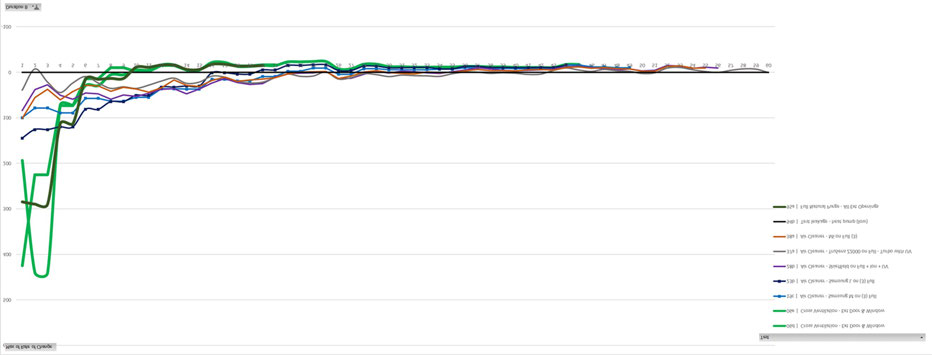
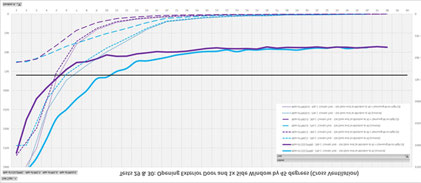
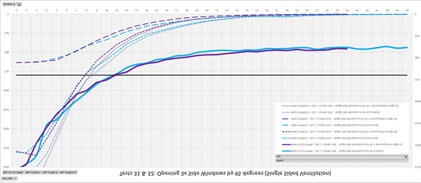
1982
Act
Information
From Ma k Je my
j
y@
y
>
Sent Sunday, 2 Janua y 2022 8 20 pm
To Scott MacKenz e Scott@sapius nz> Jason Chen jason.chen@cante bu y.ac nz> Ackley Aniebietabasi Ackley.An eb [email address] nz> Ian Longley ian.longley@n wa.co.nz> Jeff Wilson [email address] nz>
Cc Scott MacKenzie S
M
@
g
>
Sub ect RE Home Test Set #10
Happy New Yea eve yone!
This s b i liant Scott!
Looks like the ai cleane helps you each the steady-state PM level qu cke , but does not affect that steady state much, if the e s good ventilation.
Ai cleane s w ll educe total quantity of vi us nhaled by educing the levels ci culating a ound an infect ous pe son.
Official
I don t think the absolute level of PM at the sta t matte s much, if the PM sou ce is constant (like an ncense stick) as, ultimately, the most useful data f om these tests is elat ve ate of eduction.
Hope you a e getting some downtime in between the sc ence mahi!
Chee s,
Ma k
From Scott MacKenzie Scott@sap us.nz>
Sent Thu sday, 30 Decembe 2021 10 49 am
To Ma k Je my ma k je my@cante bu y ac.nz> Jason Chen jason chen@cante bu y ac.nz> Ackley An eb etabasi [email address]> Ian Longley [email address] nz> Jeff W lson [email address]>
the
Cc
@
g
Sub ect RE Home Test Set #10
Yeste day I moved into combo testing of openings ai cleane s – stick ng with the Samsung M un t unning on High speed. In all cases I moved the ai cleane out of the di ect ai path when the e was c oss vent lat on.
1. Tests 29&30 (45 deg ee opening c oss vent lat on) a e the only ones that saw the ai cleane speed up the eduction of CO2 by ~5 m ns – maybe due to wind change, o the ai cleane flow supplementing w nd path – dese ves etest.
2. Tests 31&32 (45 deg ee opening single side ventilation) showed no impact f om unning the ai cleane .
3. Tests 33&34 (3x doo c oss ventilation, 1x exte nal, 2x inte nal) had the ai cleane slow the educt on of CO2 by ~7 mins.
4. Test 35&36 (opening exte io doo and 3x windows by 10cm each) was ove all poo pe fo mance and had the ai cleane l h
of CO2 by ~17 mins.
Ac oss all the e we e some m no mp ovements in PM eduction by unning the ai cleane f om 750 down to 100 PM2.5, afte that the ai cleane does seem to have imp oved PM eduction ove no ai cleane p esent.
Need some adv ce on what level of PM you think we should be sta t ng at n this testing to make t ealistic to a class envi onment?
Today will do the full natu al pu ge of the oom w th, and without the ai cleane unning.
I also have a CO2 egulato now so can beg n c eating steady state CO2 elease which w ll be bette than flood ng the oom.
under
Scott
Released
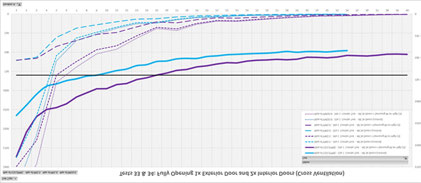
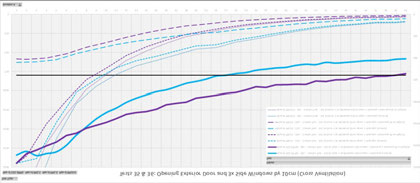

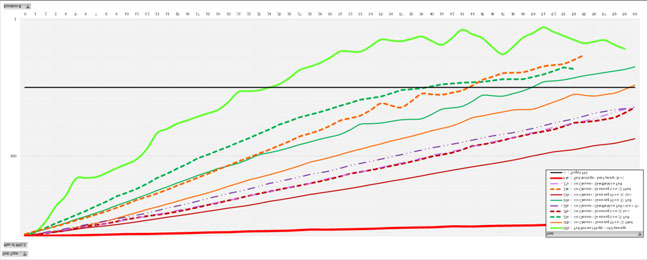
1982
From Scott MacKenzie
Sent Wednesday, 29 Decembe 2021 11 44 am
To Ma k Je my ma k je my@cante bu y ac.nz> Jason Chen jason chen@cante bu y ac.nz> Ackley An eb etabasi [email address]> Ian Longley [email address] nz> Jeff W lson [email address]>
Act
Cc
@
g
Sub ect RE Home Test Set #7
Now he e s some nte est ng PM esults – cha ts below a e both same data, bottom appl es a loga thmic scale.
- Afte 35 mins the esult of most ai cleane s sn t much of an imp ovement ove the oom s natu al decay ate (thick ed line).
- Nothing beats the full natu al pu ge, getting us down to 10 PM2.5 with n 25 mins AND has a much faste init al educt on ate (thick g een line).
- Next is Samsung L un t on full (which has 2 fans/filte s) w thin 40 m ns, but only ~4 min imp ovement between H gh and Med um fan settings.
- Samsung M un t on High sett ng takes 50 mins but s othe w se ve y close to L unit n Medium sett ng fo the most pa t.
- Low sett ngs on both Samsung M and L un ts not effective.
- Fo compa ison I d d my Sheffield un t and H gh, not eally in the ballpa k of the Samsung units.
As we know, and I t acked in the data ( efe Combo Pivot by Test, and PM Gen P vot), ai cleane s do not add ess CO2 levels. I did some nitial tests of unning the un ts w th doo s open, PM still being gene ated etc but method p oved to not be b lliant – the Samsung unit could not keep up with the inc easing PM f om 1x ncense bu ning, while
opening the exte o doo did. So next set s to t y and balance some open ng of doo s/windows to lowe CO2 (and by natu e, PM) as well as ai cleane s unn ng in the oom to also lowe PM2 - eplicat ng the windows model of needing some windows fo CO2 management but wo ied that PM wi l be too h gh.
If you wanted to exit the oom long enough fo an ai cleane to be effect ve in educ ng potentially contaminated PM, you would need to exit fo 40-60 minutes.
But it s looking to me that a 5 10 minute oom pu ge eve y hou with no ai cleane p esent will be significantly mo e beneficial unning a closed oom w th an ai cleane unning then use the money saved on the ai cleane to up the heat ng of the oom post/pu ge.
Scott
Information
Official
the
under
From Scott MacKenzie
Sent Monday, 27 Decembe 2021 9 28 am
To Ma k Je my ma k je my@cante bu y ac.nz> Jason Chen jason chen@cante bu y ac.nz> Ackley An eb etabasi [email address]> Ian Longley [email address] nz> Jeff W lson [email address]>
Cc scott mackenzie@educat on.govt.nz
Sub ect RE Home Test Set #7
Moved on to PM testing using incense st cks – wo ked we l, also did some tests with continual PM gene ation (not shown he e) - these we e all built it up then shut it off.
This shows the Samsung Med um sized un t unning at its fou speeds – low, med, high and auto. I have PM1 0, 2.5 and 10.0 data, ve y little diffe ence between 2 5 and 10 0 though 1.0 always sits lowe (thinking ncense not c eating volume of smalle pa t cles). Inte esting obse vations
- Fu l f esh ai pu ge of the oom massively mo e effect ve than an ai cleane n educing PM levels
- Only mode ate ga n unning Samsung unit on auto o high, compa ed to med um.
- CO educt on fo ai cleane s (which we know is not a th ng) shown fo completeness, d op e lects oom s natu al decay.
So opening all doo s and windows fo ~13 m ns achieves what a Samsung unit can ach eve afte ~40 m ns, noting the latte does not imp ove CO2 levels.
Next I m going to un the same test with the Samsung L unit, and maybe 2-3 othe smalle non-Samsung units I have he e.
Then onto combo testing, and active gene ation testing.
Scott
Released
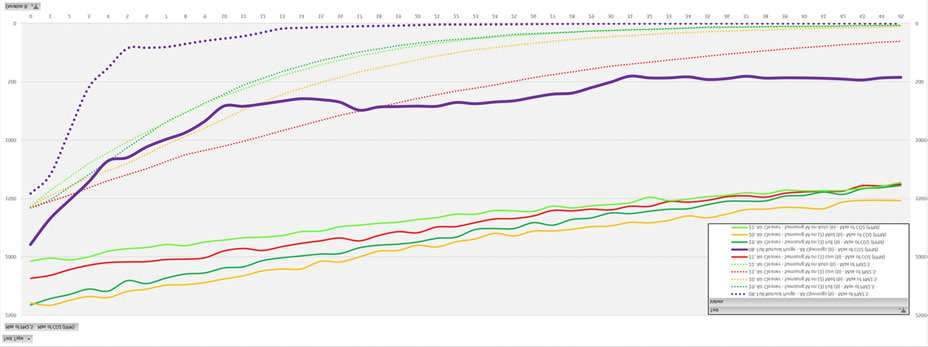

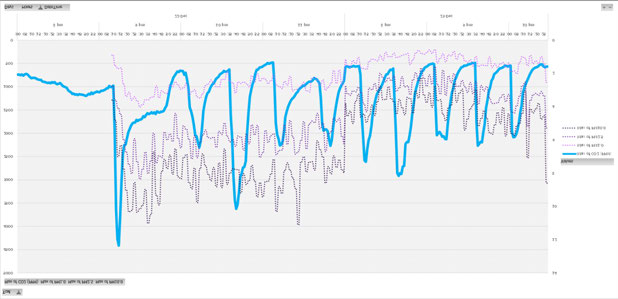

1982
From Scott MacKenzie
Sent F iday, 24 Decembe 2021 11 36 am
To Ma k Je my'
j
y@
y
> 'Jason Chen' j
h @
y
> 'Ackley Aniebietabasi'
l y
@
g
> 'Ian Longley'
l gl y@
> Je f Wilson j ff @
h-
>
Cc '[email address]' [email address]>
Act
Sub ect RE Home Test Set #2
Updated obse vations
1. The e emains no substitute fo the pu ge in qu ckly lowe ing CO2 (~5.5mins).
2. Next most effect ve is c oss vent lat on using 1x exte io doo and oppos ng window (~8 m ns), with othe nte io doo s x2 shut (p esumably having these open weakens the ai flow between the exte nal open ngs).
3. C oss ventilation (2) above is ~20% bette than single sided ventilation.
4. Using a po table fan to assist natu al ai flow is a gamble, as fac ng in vs out needs to match the natu al ai flow di ection which can change th ough the day depending on w nd di ection.
5. I am assum ng an ANVS/m xed mode solution would ove come the va iabil ty in (4) th ough inc eased fan powe – to be p oven.
6. Use of a heat pump o any othe f xed device that c eates ts own ai flow, should only be used if ts p oven to always supplement the natu al ai flow di ection – which as noted in (4) can be p oblematic. In th s case the heat pump ai di ection was 90 deg ees f om the natu al ai path (exte io to inte io doo s) – I will e- un th s test with
test 06 (exte io doo to window) which might actually supplement the natu al flow towa ds the window.
I ve now included the Pu pleAi data and cu ently showing no co elat on to CO2 and inte ventions – but now I have the datasets associated we l see what happens when we bump up the PM levels.
Ch istmas colou s a e pu ely coincidental.
Information
Official
the
under
From Scott MacKenzie
Sent Thu sday, 23 Decembe 2021 7 56 am
To Ma k Je my
j
y@
y
> Jason Chen j
h @
y
> Ackley An eb etabasi
l y
@
g
> Ian Longley
l gl y@
>
Cc
@
g
Sub ect Home Test Set #1
H , fi st set of esults below and wo kings attached, I have all the cont ol data e audit log, spec of windows/ oom/fans etc still to nclude.
Method was to flood oom with CO2 up to 2000-2500ppm, then do inte vention, and (fo most) give it 20 mins. Done back to back last night so simila outdoo conditions. Will edo single sided ventilation fo full 20 min alongside pa tial opening tests next ound. 2x inte io doo s (that eally go nowhe e f om a ventilation pe spective), 1x exte io
doo , 3x side windows. Heat pump faces ac oss the path of the exte io doo .
Observations
- Fu ly opening all doo s and windows (“pu ge”) wi l educe CO2 to 800ppm in less than 8 minutes.
- Hav ng windows on thei second latch and all doo s open (c oss vent lat on, albeit poo ) wi l educe CO2 to 800ppm n less than 15 minutes.
- Then tu ning a po table fan on n the exte io doo way blowing INTO the oom educes this to less than 9 minutes – the efo e fac ng this way s supplement ng the natu al ai di ect on (which you could not dete m ne in the oom).
- Alte natively tu ning the heat pump on, which n this oom competes with the natu al ai flow di ect on f om the exte io doo , g eatly impacts CO2 educt on time.
Have Pu ple Ai data to inco po ate next to see if/how PM levels changed du ing nte ventions.
Scott MacKenzie
Di ec o Sap us td
9(2)(a)
scot @sap us nz
Released
DISC AIMER
Th s ema l and any a tachments may onta n n o ma ion that s con den ial and sub ect o egal p ivi ege I you a e not he in ended ecip ent any use disseminat on d st bu ion o dupl cation o h s email and a tachments is p ohibi ed I you have ece ved th s email in e o please no i y the au ho mmedia e y and e ase a l copies o he ema l and attachments The Min st y o Educa ion accepts no espons bi ity o changes made to h s message o at achments a te t ansm ss on om the
M nist y
D Ian Longley
P inc pal Sc ent st - Ai Quality
P og amme Leade - Atmosphe ic Envi onment, Health and Soc ety
9(2)(a)
Nat onal Institute of Wate & Atmosphe ic Resea ch Ltd (NIWA)
41 Ma ket Place Viaduct Ha bou Auckland New Zealand
Connect with N WA niwa.co.nz Facebook L nkedIn Twitte Instag am
o ensu e compl ance w th egal equi emen s and to main a n cybe secu ty s anda ds N WA s I sys ems a e sub ect o ongo ng monito ing ac iv ty ogg ng and aud t ng his mon to ng and aud t ng se vice may be p ovided by hi d pa ies Such thi d pa t es can access in o ma ion t ansmi ted o p ocessed by and sto ed on NIWA s I sys ems
DISC AIMER
Th s ema l and any a tachments may onta n n o ma ion that s con den ial and sub ect o egal p ivi ege I you a e not he in ended ecip ent any use disseminat on d st bu ion o dupl cation o h s email and a tachments is p ohibi ed I you have ece ved th s email in e o please no i y the au ho mmedia e y and e ase a l copies o he ema l and attachments The Min st y o Educa ion accepts no espons bi ity o changes made to h s message o at achments a te t ansm ss on om the
M nist y

1982
Act
Information
Official
the
under
Released
From:
Ian Longley
To:
Mark Jermy; Robyn Phipps; Scott MacKenzie; Jason Chen
Subject:
RE: For review - toolkit letter and CO2 info.docx
Date:
Monday, 31 January 2022 11:18:23 am
Attachments:
DRAFT - toolkit letter and CO2 info IL.docx
Here’s mine. Sorry – did these before Robyn’s came through so they don’t incorporate her o
Mark’s changes.
Ian
1982
From: Mark Jermy <[email address]>
Sent: Monday, 31 January 2022 11:13 AM
To: Robyn Phipps <[email address]>; Scott MacKenzie
Act
<[email address]>; Jason Chen <[email address]>; Ian Longley
<[email address]>
Subject: RE: For review - toolkit letter and CO2 info.docx
Morning all! A few comments from me in addition to Robyn’s.
From: Robyn Phipps <[email address]>
Sent: Sunday, 30 January 2022 9:43 am
To: Scott MacKenzie <[email address]>; Mark Jermy
Information
<[email address]>; Jason Chen <[email address]>; Ian Longley
<[email address]>
Subject: Re: For review - toolkit letter and CO2 info.docx
Some comments from me in track changes.
Official
Robyn
the
From: Scott MacKenzie <[email address]>
Date: Friday, 28 January 2022 at 2:54 PM
To: Mark Jermy <[email address]>, Jason Chen
<[email address]>, Ian Longley <[email address]>, Robyn Phipps
under
<[email address]>
Subject: FW: For review - toolkit letter and CO2 info.docx
Hi first look at letter to go with monitors as discussed, expect some minor tweaks before ready for
VTAG review but any immediate reactions/feedback appreciated – as getting our narrative clear
on this is now impacting CO2 deployment.
There’s a lot of more specific guidance been dropped from this which I hope will find its way onto
Released
the online page to be built behind it – your thoughts on it being too light etc appreciated, but
special focus is risk/benefit of this initial focus on PPM while the calculator builds up some
pace/credence.
Scott MacKenzie
Programme Director, Ventilation
Mobile 9(2)(a)

1982
Act
Information
Official
the
under
Released
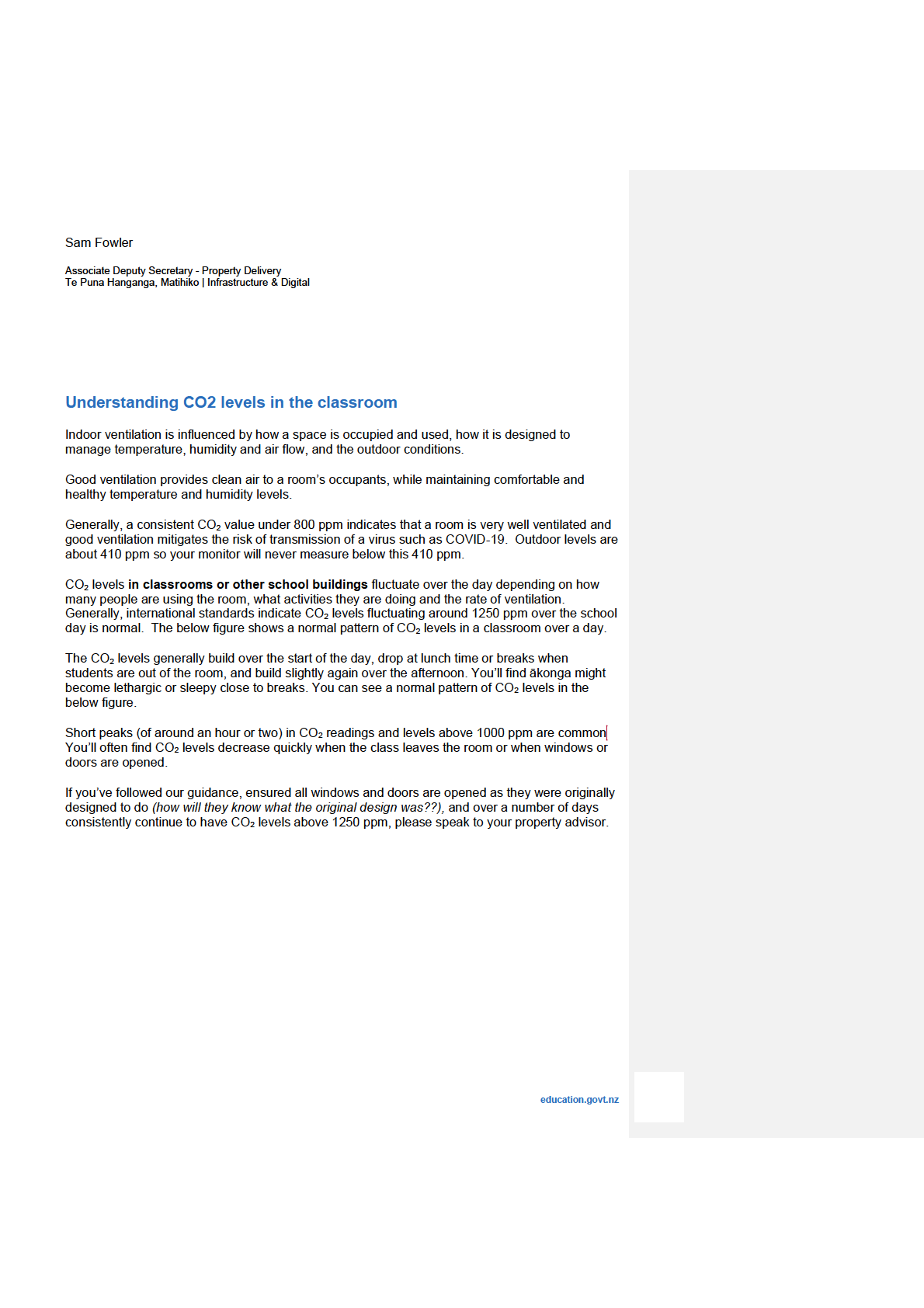
1982
Act
Information
Official
the
under
Released
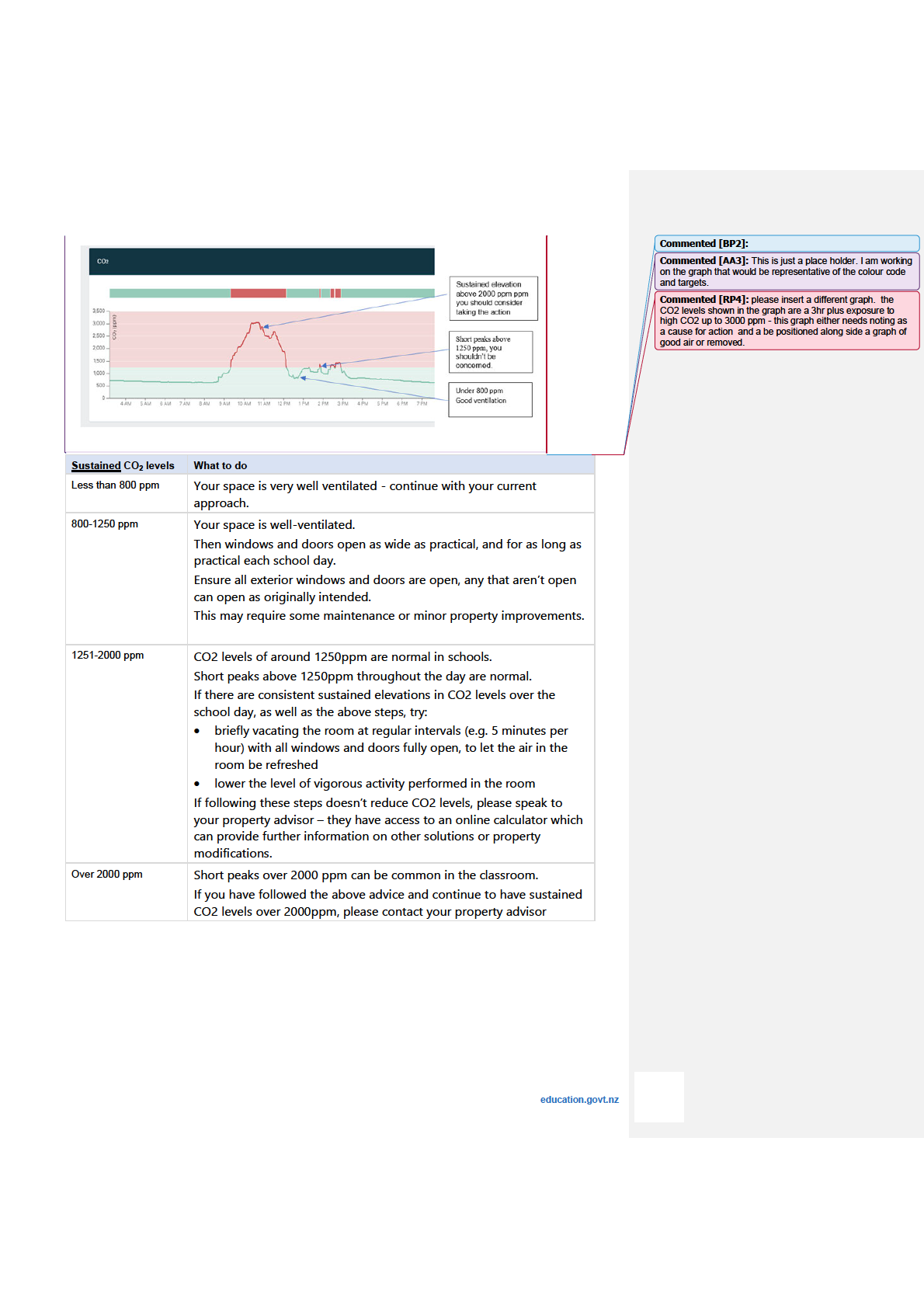
1982
Act
Information
Official
the
under
Released
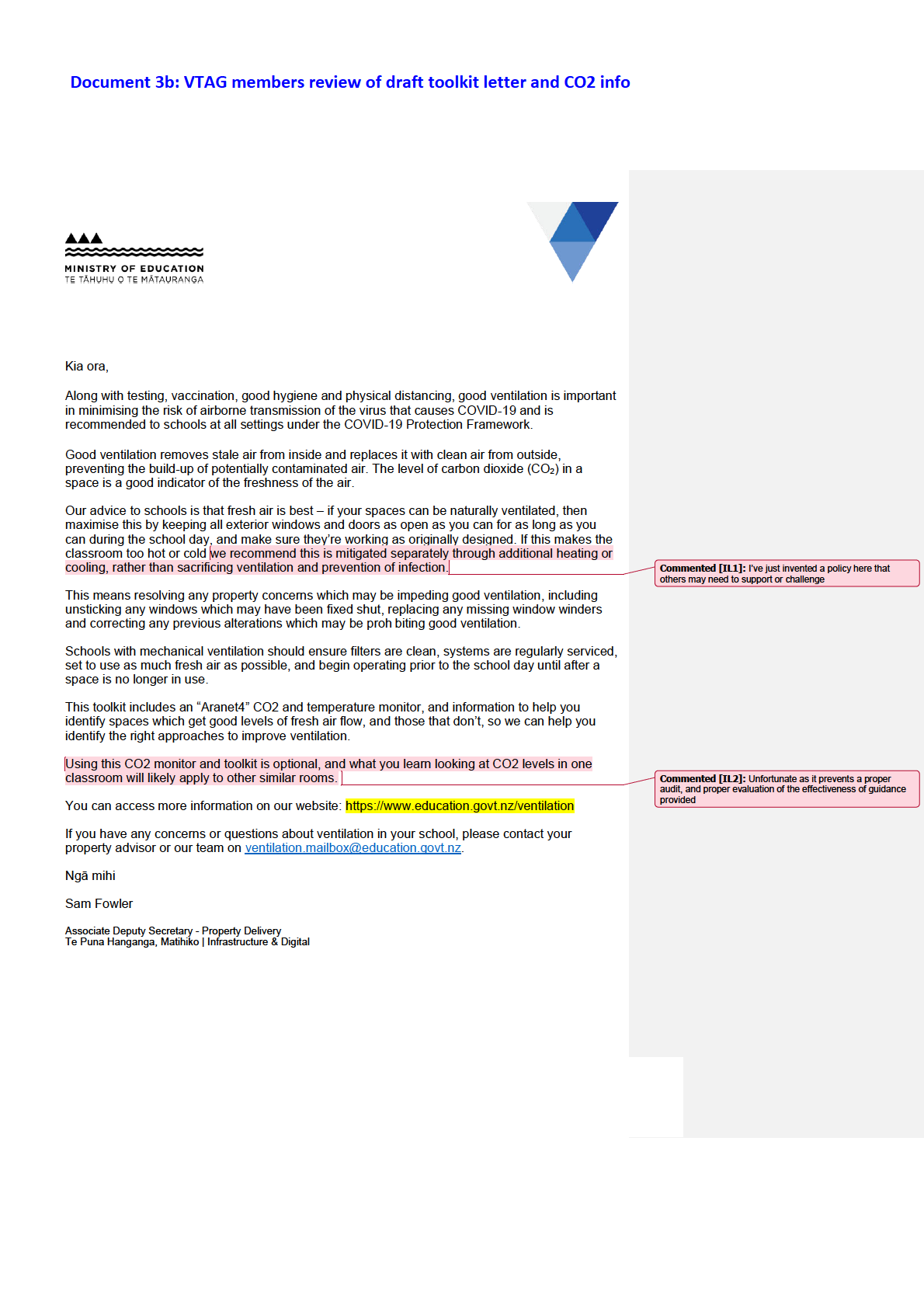
1982
Act
Information
Official
the
under
Released
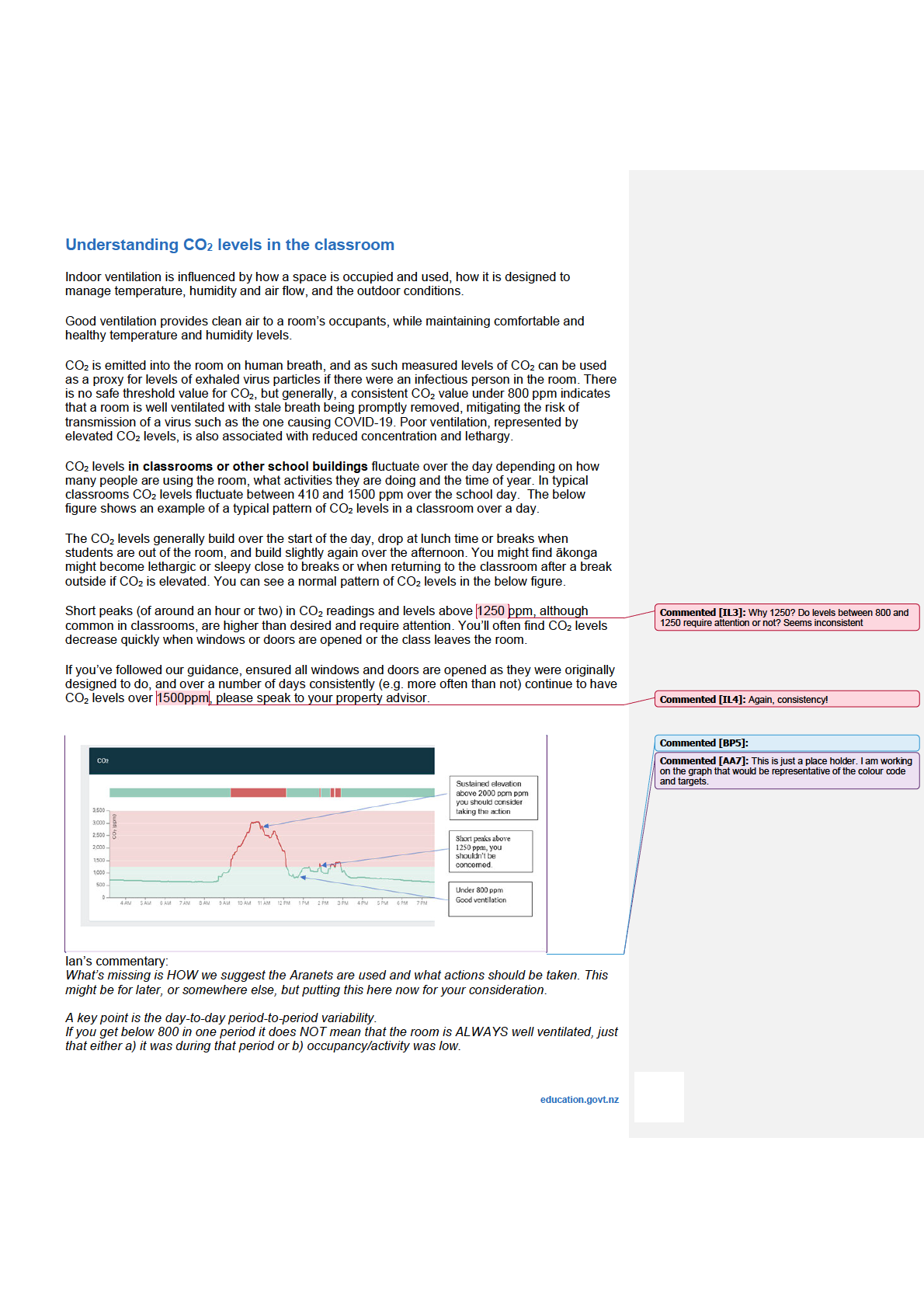
1982
Act
Information
Official
the
under
Released
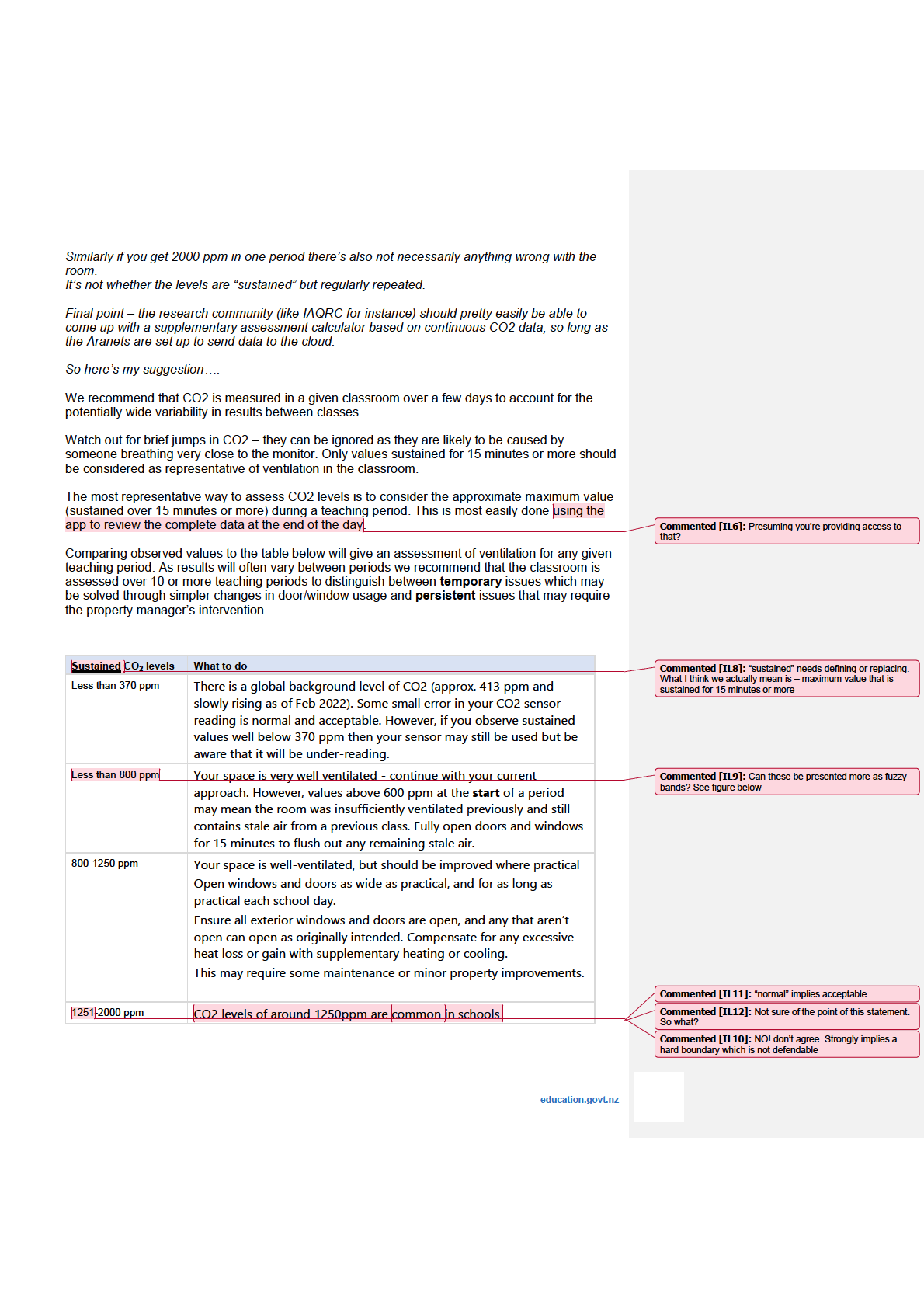
1982
Act
Information
Official
the
under
Released
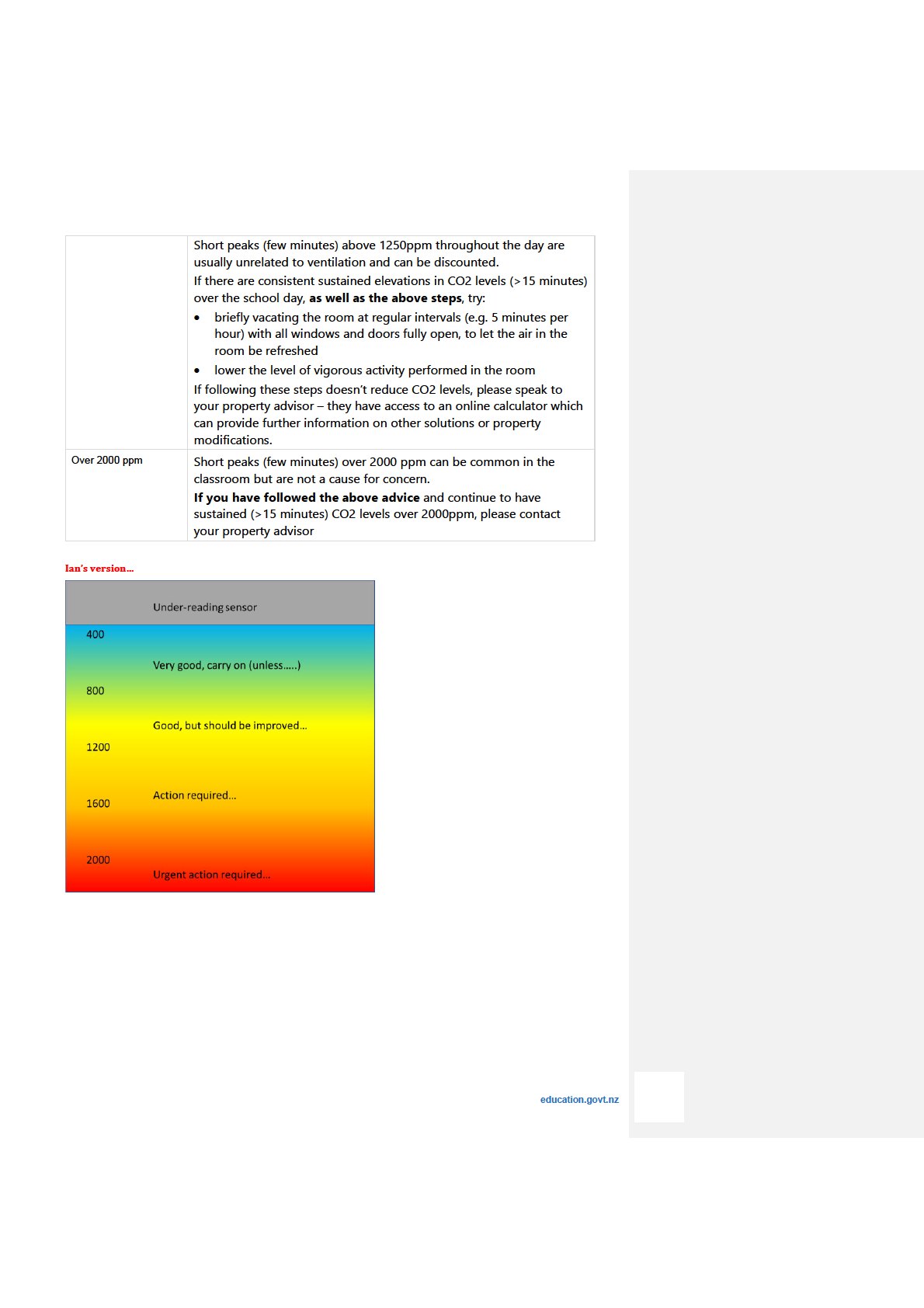
1982
Act
Information
Official
the
under
Released
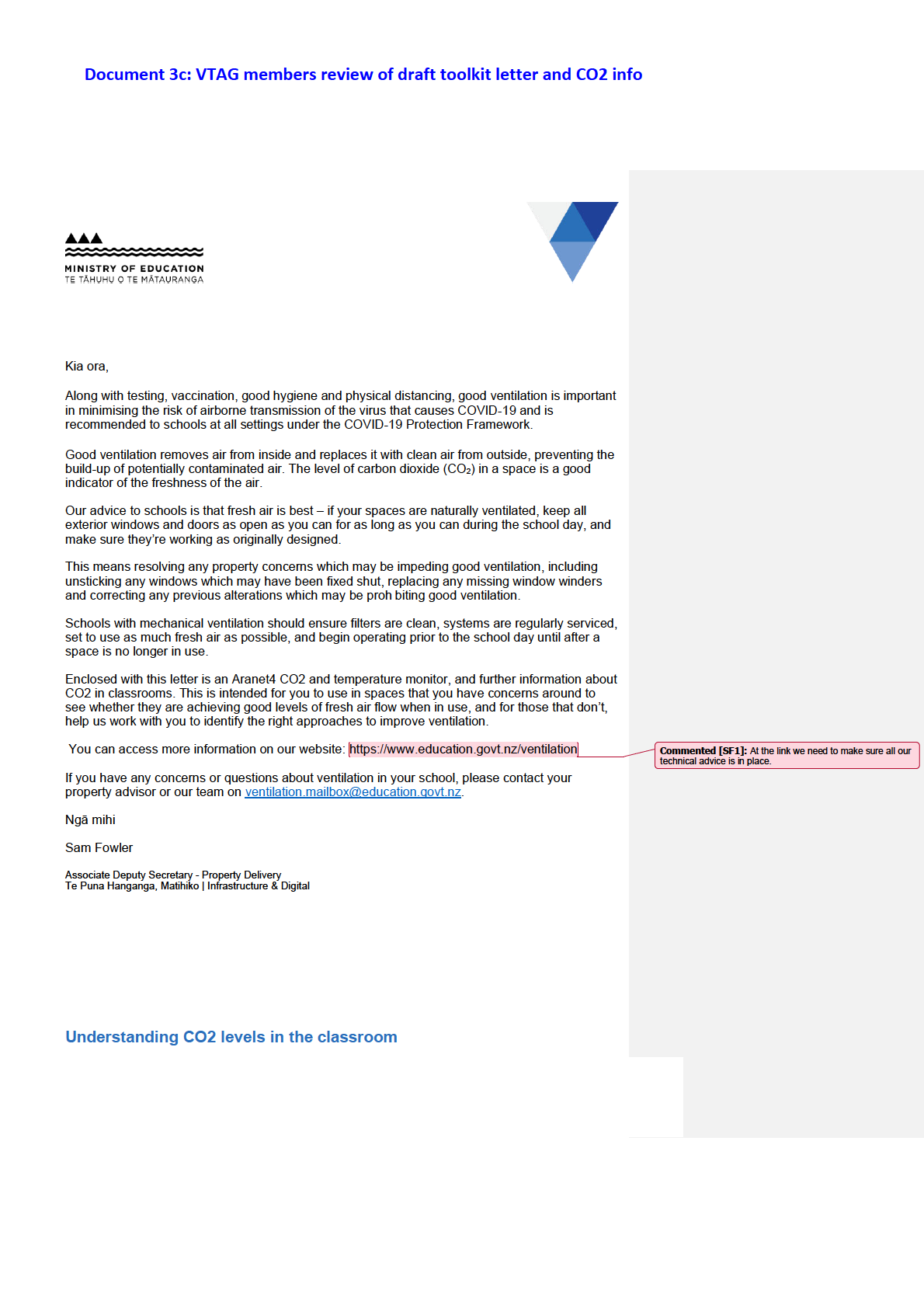
1982
Act
Information
Official
the
under
Released

1982
Act
Information
Official
the
under
Released
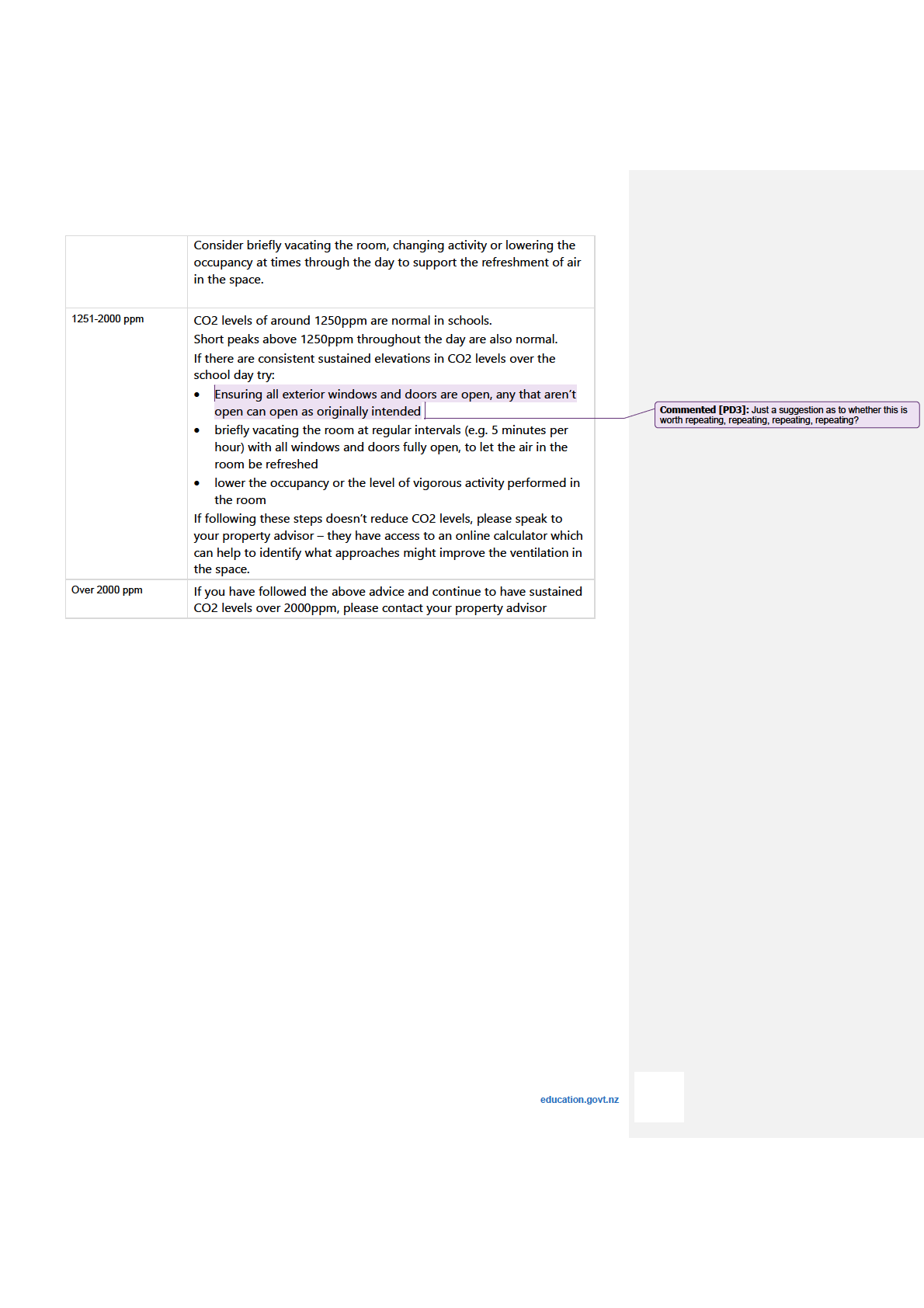
1982
Act
Information
Official
the
under
Released
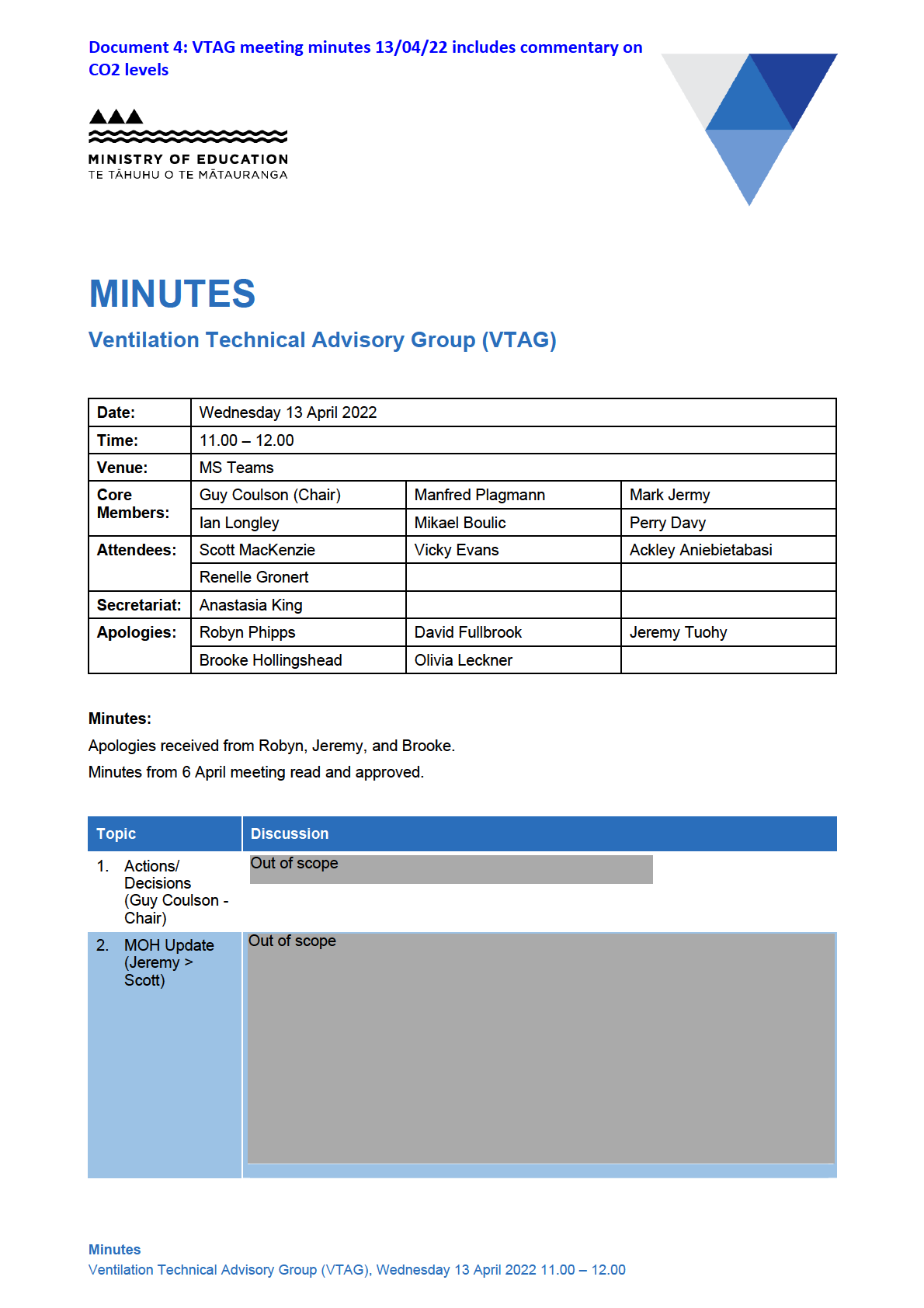
1982
Act
Information
Official
the
under
Released
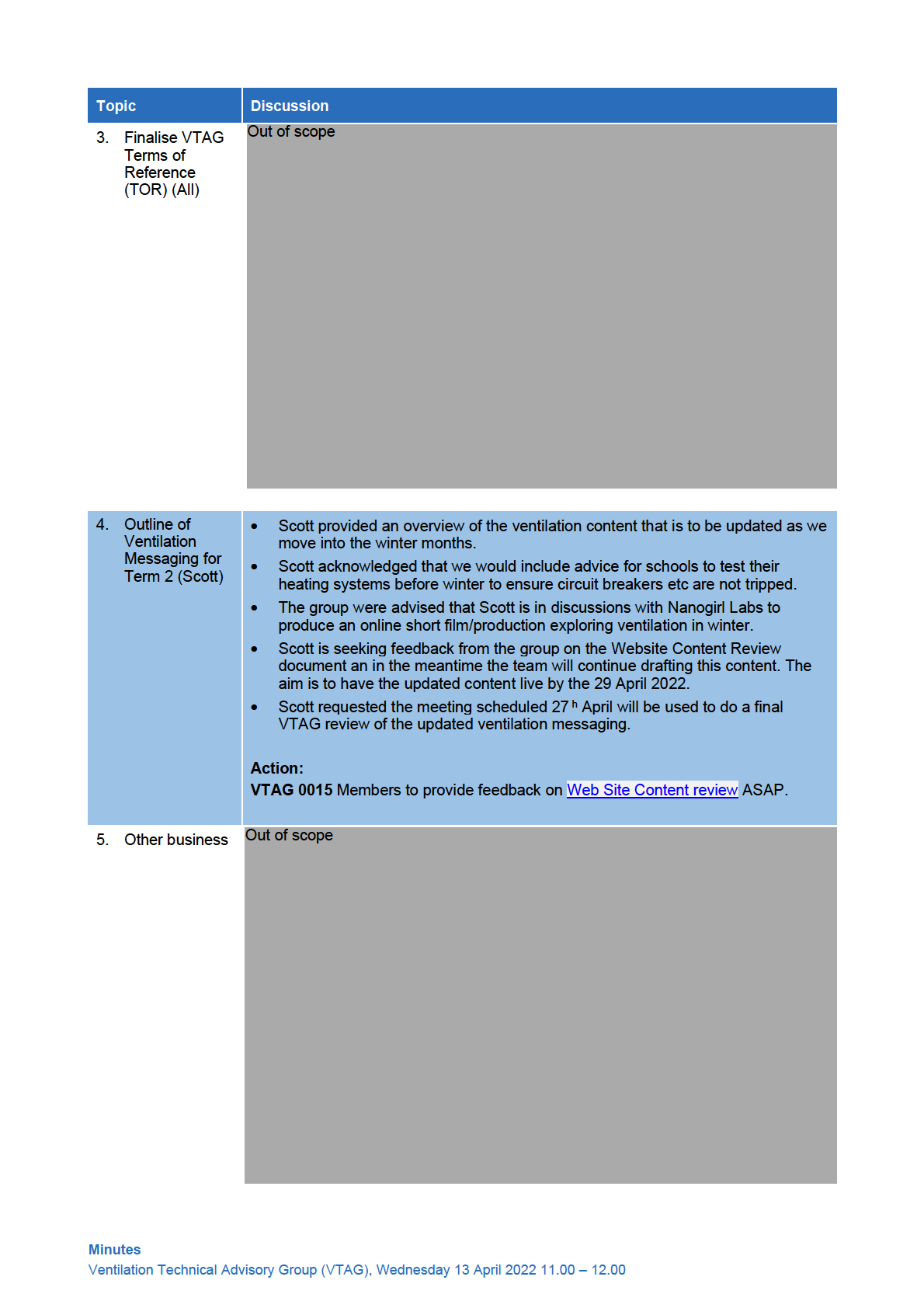
1982
Act
Information
Official
the
under
Released
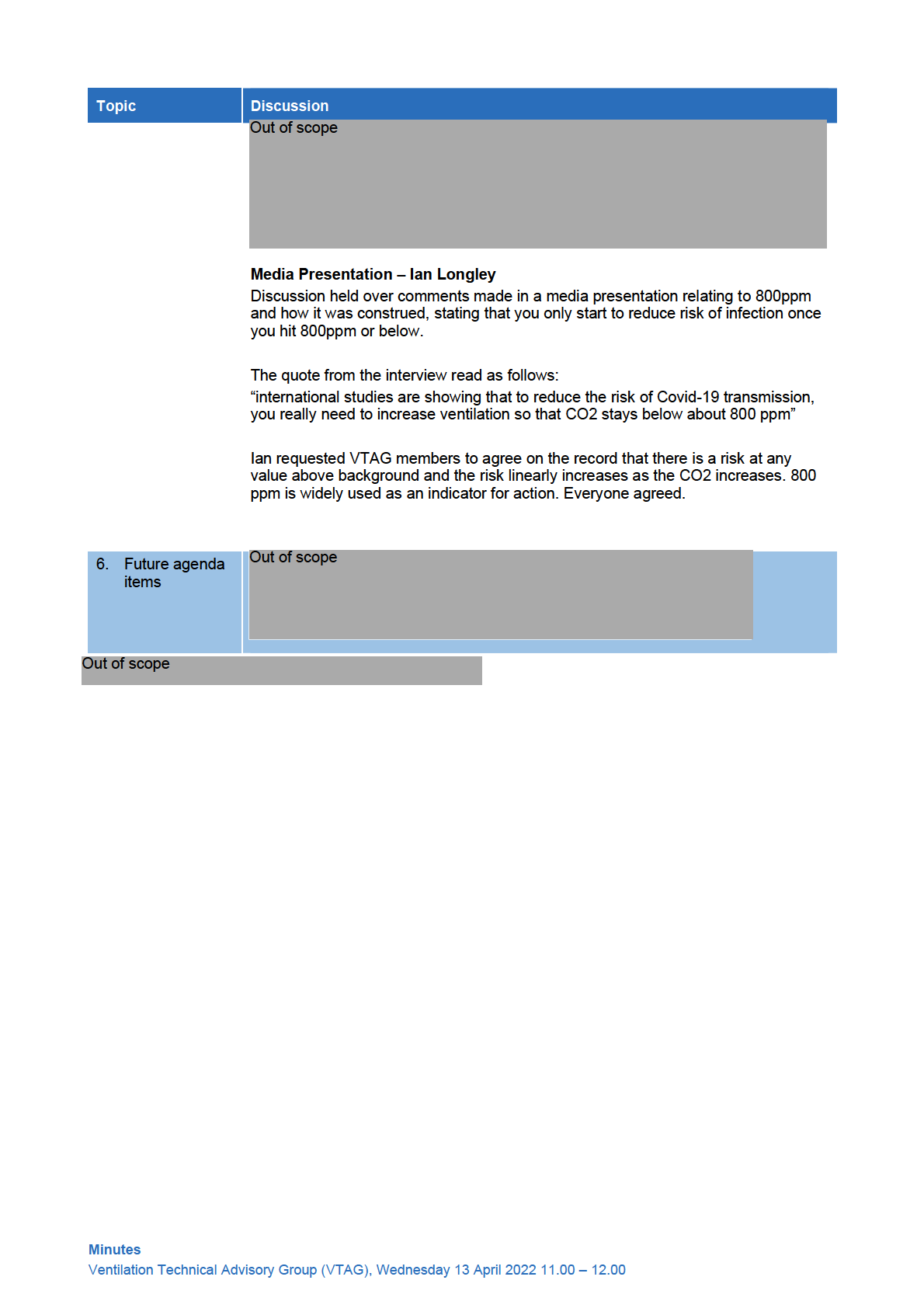
1982
Act
Information
Official
the
under
Released
Out of scope
1982
Act
Information
Official
the
under
Released
1982
Act
Information
Official
the
under
Released

1982
Act
Information
Official
the
under
Released
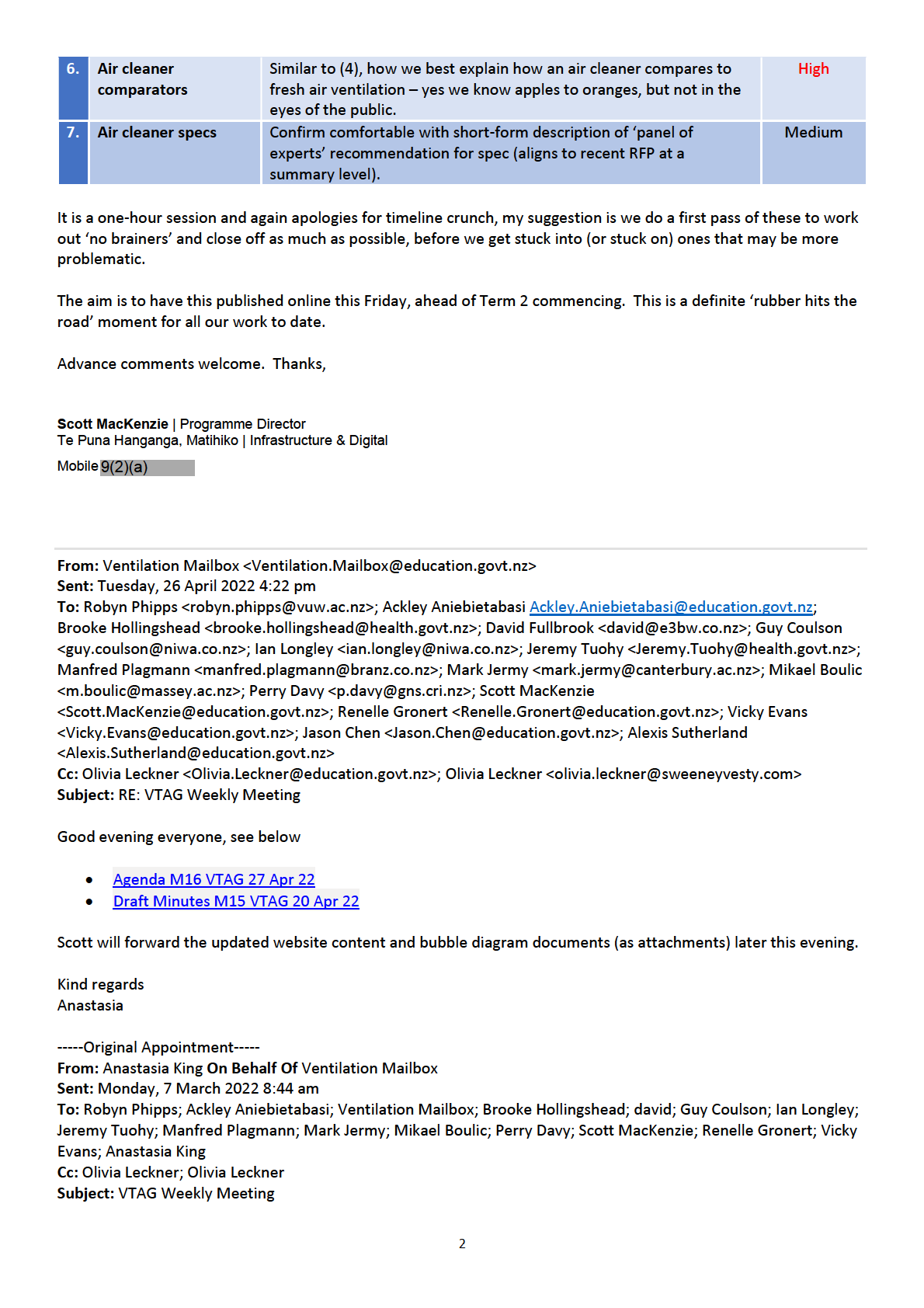
1982
Act
Information
Official
the
under
Released
When: Wednesday, 27 April 2022 1:00 pm-2:00 pm (UTC+12:00) Auckland, Wellington.
Where: Microsoft Teams Meeting
Good afternoon everyone,
An agenda and draft minutes and supporting papers will be sent out by midday Monday each week.
Kind regards
Anastasia
____________________________________________________________
1982
Microsoft Teams meeting
Act
Join on your computer or mobile app
Click here to join the meeting
Learn More | Meeting options | Legal
________________________________________________________________________________
Information
Official
the
under
Released
3
Document 5a: Attachment to email for 27/04/22 meeting
Pre-Winter Ventilation Checklist:
Making sure indoor spaces are well ventilated and have lots of fresh air is recommended for schools.
This applies at all levels of the COVID-19 Protection Framework in addition to using face coverings,
physical distancing, good hygiene and other health measures.
Schools can use this checklist to help you to prepare for the winter session ahead. The bigger the
temperature difference between the outside and inside, the more efficiently fresh outside air is
drawn in through open windows. This allows good ventilation to be achieved on colder days with
windows partially open, which helps to maintain a comfortable indoor temperature.
1982
Act
Room Name:
_____________________________
Date:
_____________________________
Openable windows and doors:
Most schools are designed to be naturally ventilated, with opening windows and doors providing
fresh air. For your naturally ventilated spaces, please check: Information
1. All windows open as originally designed and have not been fixed or painted shut.
2. All windows can open freely without having to be forced.
3. Any window winders, hinges, catches or closers that are missing or broken, have
been remediated.
Official
4. Window or security latches are able to hold windows partially open by small
amounts – for example 2cm, 5cm, and 10cm.
the
5. Exterior doors that are generally sheltered from adverse weather can be held or
latched partially open, if this is required to boost the flow of fresh air.
6. Interior doors that connect to internal corridors or other circulation spaces can be
held or latched partially open, if this is required to create a cross flow of air.
under
Heat pumps and other heating systems
Naturally ventilated spaces can have differing heating systems including boilers/radiators, heat
pumps and fitted electric heaters. Please check:
1. The room’s heating system(s) are working as originally designed and intended.
2. Ensure that regular cleaning or maintenance on heating system(s) are up to date.
Released
3. Run the heating at its highest setting for a period to test that it performs as
expected and doing so does not create other issues, e.g. tripping circuit breakers.
4. Prior to the coldest time of the winter season, trial setting the heating system(s)
with windows open to determine how you might maximise the flow of fresh air
while also maintaining a comfortable indoor temperature.
Ducted mechanical ventilation systems (if fitted)
Ducted mechanical ventilation systems automatically source fresh air from the outside while also
managing the temperature of the room. One way to identify if your space has a ducted mechanical
ventilation system is to look for vents in the ceiling that bring in fresh air or extract old air.
1982
Configuration and maintenance of ducted ventilation systems should only be done by appropriately
skilled technicians. Please check:
Act
1. The system has been recently checked, cleaned and maintained by an
appropriately skilled technician.
2. This system has been configured to come on at least two hours before the start of
the school day, and to stay on for two hours after the school day ends.
3. Prior to the coldest time in the winter season, ensuing the system is successfully
managing the amount of fresh air brought it (as measured by a CO2 monitor) while
maintaining a comfortable indoor temperature.
Information
Carbon Dioxide (CO2) monitoring
Measuring CO2 levels indicates how well-ventilated a room is. When in use, portable CO2 monitors
are to be positioned at around student head height, away from doors and windows, out of direct
Official
sunlight, and at least 1m away from the closest people. While the room is occupied, please:
1. Use your senses to determine if the room feels stuffy or has lingering smells, and if
the
so, follow our guidance to try and improve ventilation.
2. If the concern is not quickly alleviated, next try performing intermittent spot
checks through the day by placing your portable CO2 monitor in the room for at
least 5 minutes then reviewing the CO2 levels against our published guidance.
under
3. If the spot check indicates there may be consistent and sustained CO2 levels over
the school day, next leave your portable CO2 monitor in the room for at least a full
day to gather readings that can be shared with your Ministry Property Advisor
alongside details of the room’s dimensions, number of students, use of heating
and window openings.
* NOTE short peaks in CO2 levels over 1250ppm throughout the day are common, and peaks over
2000ppm can occur. If you have followed the published guidance and continue to have consistent
and sustained CO
Released
2 levels over 2000ppm, please contact your Minister property advisor.
Further assistance
• Please contact your Ministry property advisor if you require additional support to address
any ventilation concerns, or you can contact the Ministry’s ventilation team on
[email address].
• A technical ventilation calculator tool is used by the Ministry’s ventilation team to further
assess what property improvements may be needed to address ventilation challenges. If
requesting additional support, the team will require specific details of the room’s usage,
dimensions, doors, windows and window openings, supporting floor plans and photos, and 1982
any CO2 readings that are available.
• Ventilation guidance for all schools is available online: https://temahau.govt.nz/covid-
Act
19/advice-schools-and-kura/ventilation-schools.
Information
Official
the
under
Released
Document 5b: Attachment to email for 27/04/22 meeting
Ministry of Education: “Term 2” Ventilation Online Guidance
Ventilation Technical Advisory Group (VTAG) Content Review - Final Draft
Dated 26 April 2022
IN CONFIDENCE – NOT FOR DISTRIBUTION – SUBJECT TO INTERNAL APPROVALS
Legend:
1982
CYAN
=
Headings
GREEN
=
VTAG area of interest / discussion
YELLOW
=
Ministry review still WIP
Act
L1 page: Ventilation in schools
H1: Ventilation in schools
Good ventilation helps slow the spread of the virus that causes COVID-19.
Making sure indoor spaces are well ventilated and have lots of fresh air is always recommended
Information
for schools. This applies at all levels of the COVID-19 Protection Framework in addition to using
face coverings, physical distancing, good hygiene and other health measures.
The best way to maximise ventilation is to open all windows and doors as much as possible, and
whenever it is practical to do so. The exception to this is spaces that are fitted with ducted air
conditioning systems (excluding heat pumps), which do not rely on opening windows to bring in
Official
fresh air.
Follow our guidance to fine-tune your school’s ventilation strategies to maintain comfortable
indoor temperatures while achieving good ventilation.
the
Subheading: Ventilation help in winter
Air flow behaves differently at different temperatures – for example, the bigger the temperature
difference between outside and inside, the more efficiently fresh outside air is drawn in through
under
open windows. This means ventilation can work better during cold weather, so you can still
achieve good ventilation with windows just partially open.
There are several ways to do this depending on your school’s design, how each space is being
used and the outdoor conditions.
Read our tips on how you can do this, with posters and pre-
winter checklists available on our
resources page.
Support is available to schools who are concerned about maintaining good ventilation. This
includes:
Released
• specific ventilation advice from our COVID-19 ventilation team
• an operational funding grant that will become available to all schools in Term 2, to assist
with additional heating costs during winter
1
• funding of urgent property improvements over $5,000 that are required to achieve good
ventilation
• the free supply of a limited number of portable air cleaners and CO2 monitors, being
distributed to all schools in Term 2
• the supply of additional portable air cleaners where this is found to be the correct interim
or supplementary solution
• the ability to purchase suitable portable air cleaners and CO2 monitors from the Ministry’s
nominated suppliers at discounted pricing.
For ventilation advice and to access this support, please contact your Property Advisor or our
1982
COVID-19 ventilation team on [email address].
Act
TILE 1 link to separate page: Ventilation guidance
TILE 2 link to separate page: Assessing ventilation
TILE 3 link to separate page: Ventilation resources
L2 page: Ventilation guidance
H1: Ventilation guidance
A space’s ventilation will be influenced by how it was designed, how it is currently being used,
Information
and the outdoor conditions. Good ventilation will provide fresh, clean air while maintaining
comfortable temperature and humidity levels for the people in the space.
Good ventilation helps reduce COVID-19 airborne transmission by quickly and consistently
removing the old air and replacing it with fresh, clean air.
Indicators that a space may not be well-ventilated include a feeling of stuffiness, lingering smells
Official
and
elevated CO2 levels created by the people in the room.
You can quickly improve the air quality in any space by:
the
• limiting more vigorous activities, or moving them outdoors or to a better ventilated space
• limiting the number of people, especially in smaller, confined spaces
• fully opening all windows and doors to flush the air in the room, and where it’s an option
to do so, briefly vacating the room at the same time.
under
<Quick links/jump links/contents/on this page>
•
Guidance for all naturally ventilated spaces
•
Guidance for naturally ventilated spaces on cold, wet or windy days
•
Guidance for ducted, mechanically ventilated spaces
•
Guidance for using heat pumps and other heating systems
Released
•
Other supplementary solutions
2
H2: Guidance for all naturally ventilated spaces
Most New Zealand schools and classrooms are naturally ventilated using windows that can be
opened. Make the most of this by:
• Opening all windows and doors as much as possible, and whenever it is practical to do
so. Do not wait for a space to get stuffy before opening windows and doors.
• Opening all windows before the school day starts and having them open whenever the
room is vacated during the day.
• Opening windows and doors on the opposite sides of a room where possible to enable the
cross flow of air, including any that connect to internal corridors or other circulation spaces.
1982
• Turning on any fitted ceiling fans to increase air movement, but only when the windows
are open to avoid recirculation of stale air.
Act
• Taking regular short breaks (5-10 minutes each hour) where everyone exits the space
with the windows and doors fully opened, to flush the space with fresh air.
Regularly check for any property issues that may need to be resolved, such as:
• ensuring any window that was originally designed to open, can still open
• unsticking windows which may have been fixed or painted shut
• replacing missing or broken window winders, hinges, catches or closers
Information
• correcting any previous alterations which may be impeding good ventilation
Please contact your Ministry property advisor if you require additional ventilation support to
address any property concerns.
Official
H2: Guidance for naturally ventilated spaces on cold, wet or windy days
the
Bad weather can make it impractical to fully open windows and doors, but on cold days good
ventilation can still be achieved with windows partially opened.
This is because air flow behaves differently at different temperatures – for example, the bigger
the temperature difference between outside and inside, the more efficiently fresh outside air is
drawn in through open windows.
under
For example:
• as a rule of thumb, it’s possible to achieve good ventilation when partially opening all
windows by 5cm
• having two windows open by 10cm each through the day provides the same benefit as
running a large portable air cleaner, while also creating fresh air flow
• fully opening all windows and doors for three minutes every hour provides the same benefit
as running a large portable air cleaner for 20 minutes, while also creating fresh air flow
Released
On colder days, in addition to our general ventilation guidance, try to:
• Pre-heat spaces before the start of the school day. Having it warm inside improves the
draw of fresh air through partially opened windows.
3
• Increase indoor heating during the day, if you need to, to offset the impact of having the
windows partially open when it’s cold outside.
• Where high level windows are fitted, open these first and wider than low level windows to
reduce cold draughts in the room.
• Open lots of windows a little, rather than a few windows a lot. Close the door before you
begin closing windows, reduce or close any windows directly facing the worst weather
conditions (e.g. wind, rain or snow).
• On a wet day, try to keep wet clothes out of the classroom as bringing them in will make
the classroom more difficult to heat.
1982
• Consider adjusting the classroom layout to move students away from open windows, and
other areas that may have cooler air or draughts.
•
Act
Consider relaxing uniform rules/dress codes and allowing warmer clothes to be worn, for
people who are more sensitive to colder air and draughts.
• Continue to use refresh breaks, where all windows and doors are fully opened and
preferably everyone exits the room for a few minutes each hour.
• Fine-tune your approach through the day as the weather changes. Fully opening windows
still achieves the best ventilation, so increase your window openings if it warms up outside
later in the day or whenever this can be done while maintaining a comfortable indoor
temperature.
Information
Continue
using your portable CO2 monitors to check if your ventilation is working effectively, in
addition to the appropriate use of face coverings, physical distancing, good hygiene and other
health measures.
An operational funding grant will become available to all schools in Term 2, to assist with
additional heating costs during winter. More information about this will be made available in May.
Official
H2: Guidance for ducted, mechanically ventilated spaces
the
Some schools are fitted with ducted mechanical ventilation systems that automatically source
fresh air from the outside while also managing the temperature of the room. These are often
referred to as HVAC or air conditioning systems. This doesn’t include heat pumps, because they
don’t supply fresh air.
under
One way to identify if your space has a ducted mechanical ventilation system is to look for vents
in the ceiling that bring in fresh air or extract old air.
Where ducted mechanical ventilation systems are fitted, the above advice for naturally ventilated
spaces doesn’t apply unless the system has specifically been designed to work in conjunction
with windows and doors being open. If not, windows and doors should remain closed to allow the
system to work as designed.
A well-configured ducted mechanical ventilation system will provide good ventilation while
managing indoor temperatures. Make the most of this by:
Released
• Ensuring the system is regularly checked, cleaned and maintained by an appropriately
skilled technician.
• Having the system configured to come on at least two hours before and after the school
day.
4
• Increasing the amount of fresh air brought in by the system and minimising the amount of
old air it filters and recirculates.
• Continuing to
use your portable CO2 monitors to check if the system is working
effectively.
Configuration and maintenance of ducted ventilation systems should only be done by
appropriately skilled technicians. Technical guidance on this topic is available on our
resources page.
H2: Guidance for using heat pumps and other heating systems
1982
You can continue to use heat pumps to heat or cool spaces, even when windows and doors are
open.
Act
Heat pumps and most other heating systems only heat or cool recirculated air within the space.
They do not bring in fresh air, so to achieve good ventilation they must be used alongside a means
of providing fresh air.
When using heat pumps and other heating systems:
• pre-heat the space to a comfortable temperature before the school day to improve the
draw of fresh air through partially opened windows
• increase indoor heating or cooling during the day, if you need to, to offset the impact of
having the windows open
Information
• resetting the temperature of the room to a comfortable level after it has been vacated and
aired out, by briefly closing all windows and doors and running the system on its highest
setting before re-occupying the room and re-opening windows.
Ahead of the colder months, your heat pump or heating system should be checked and serviced
to make sure it is running at its best.
Official
Using a heat pump with windows open will be less efficient and may incur some additional power
costs. An operational funding grant will become available to all schools in Term 2, to assist with
additional heating costs during winter. More information about this will be made available in May.
the
H2: Other supplementary solutions
H3: Portable air cleaners (purifiers)
Air cleaners are a supplementary solution that, in some cases, may be suitable to use in
under
combination with good ventilation practices in spaces that are challenging to ventilate well.
Air cleaners can reduce COVID-19 airborne transmission by filtering and recirculating the air
within a space. They do not replace ventilation in any circumstances, and do not reduce CO2
levels.
It is more effective and beneficial to use a space’s natural or mechanical ventilation to supply
fresh air. For example:
• Good ventilation is consistent throughout a space, while the benefits from air cleaners can
Released
be localised to the immediate area they are placed in, especially for smaller units with a
Clean Air Delivery Rate (CADR) under 400 m3/hour.
• Running a large (700 CADR) HEPA air cleaner on its highest setting will clean and
recirculate the air in a space at the same rate as having two windows open by 10cm each
through the day, but the windows will also create a flow of fresh air and reduce CO2 levels.
5
• Running the same large air cleaner will clean and recirculate the air in a space in 20
minutes, whereas fully opening all windows and doors will fully refresh the air within three
minutes.
Due to these factors, in some circumstances air cleaners are appropriate but they are not the
primary or most effective method of reducing COVID-19 airborne transmission.
All state and state-integrated schools have been offered air cleaners to use at their discretion in
spaces that may have a higher risk of airborne transmission such as some staff rooms, music
rooms, high-use meeting and break-out rooms. Units are being distributed starting from March
1982
2022.
Additional air cleaners are available for schools where ventilation cannot be improved through
other immediate measures. Please contact your Ministry Property Advisor for assistance and
Act
consultation to determine if air cleaners are the right interim solution for your school.
As the Ministry will supply air cleaners to schools where they are required, there should be no
need for schools to purchase their own, however some schools may elect to do so at their own
cost.
In May 2022 we will advise arrangements for schools and other education sector entities to
purchase air cleaners direct from the Ministry’s selected supplier, at a discounted price.
If purchasing brands outside of these arrangements, our panel of experts recommend air cleaners
that use H13-14 HEPA filters, have a Clean Air Delivery Rate (CADR) greater than 400 m3/hour,
Information
operate at less than 60dB and do not use any emerging technologies the emit particles into the
air (for example ionisers, plasma discharge, ozone generators, photocatalytic oxidation, and
hydrogen peroxide).
H3: Ceiling and other fixed fans
Official
You can use ceiling fans and other fixed fans with windows and doors open, provided they do not
interfere with the natural flow of air. Do not use fans when windows and doors are closed.
Well-designed and positioned ceiling fans can boost natural ventilation by up to [x]% when used
the
in conjunction with opening windows and doors. If you are considering fitting new fans, please
discuss with your Ministry Property Advisor first to ensure that they will improve existing
ventilation.
under
H3: Portable fans
We recommend limiting use of portable fans as it can be difficult to determine whether they are
assisting or interfering with air flow. Portable fans are also noisy and can be a safety hazard
depending on how they are positioned in the room.
Most non-industrial portable fans do not produce sufficient air movement to offer a notable
improvement to ventilation.
Do not use portable fans when the windows and doors are closed, including in spaces with ducted
Released
mechanical ventilation systems.
L2 page: Assessing ventilation
6
There are several ways to quickly assess whether a space is well ventilated. Your senses can
give a good immediate indication – for example if a room feels stuffy or has lingering smells, it
may not be well ventilated. You’l be able to verify this using your CO2 monitor.
If you can’t resolve ventilation issues using our guidance, or you are concerned about ventilation
in your school you can contact your Ministry Property Advisor or the Ministry’s ventilation team
on [email address].
H1: Carbon dioxide (CO2) monitoring
Measuring CO2 levels indicates how well-ventilated a space is when it is occupied. Elevated CO2
1982
levels means fresh air isn’t flowing into a space quickly enough to meet the needs of the space’s
occupants. If sustained at elevated levels this can cause drowsiness and concentration issues for
the people in the space.
Act
Also, if the air in a space is not replaced quickly enough, pollutants and airborne particles including
viruses stay in the air for longer. That means if anyone in the room is infectious with COVID-19,
the risk of airborne transmission of the virus is increased.
To help schools assess CO2 levels, we have distributed portable CO2 monitors to all state and
state-integrated schools, with more being distributed in May 2022. Some spaces already have
fitted CO2 monitoring devices (via Internal Environment Monitors).
With winter approaching it is important to have a regular routine in place of checking CO2 levels
to gauge how well the supply of fresh air is being balanced with maintaining comfortable indoor
temperatures. This is in addition to the appropriate use of face coverings, physical distancing,
Information
good hygiene and other health measures.
H2: How to set up your CO2 monitor
1. Follow the manufacturer’s instructions in the box. To activate the device, fit the two
supplied AA batteries. There is no on/off switch or other controls on the device that need
Official
to be set.
2. Prior to first use, sit the device outside for 15-30 minutes to let it calibrate to the outdoor
the
fresh air CO2 levels (approx. 420ppm).
3. Download the Aranet smartphone app from Google Play or the Apple App Store. The app
allows you to connect to the device via Bluetooth to track readings over time and download
the readings for up to seven days, in CSV format. Doing this will avoid you having to
manually record the readings.
under
4. With the app there is the option to change the measurement interval to our recommended
setting of every 2 minutes, and to adjust the warning levels to match our advice presented
below.
H2: Using your CO2 monitor to perform spot checks
Spot checks provide an immediate indication of current CO2 levels. If the levels are high, follow
our guidance to try to lower it and also consider if you should monitor the space’s CO2 levels over
Released
a longer duration.
1. Take the device to each space and place it at around student head height, away from
doors and windows, out of direct sunlight, and at least 1m away from the closest people.
Note breathing directly into or over the device will cause it to report high CO2 levels.
7

1982
Act
Information
Official
the
under
Released
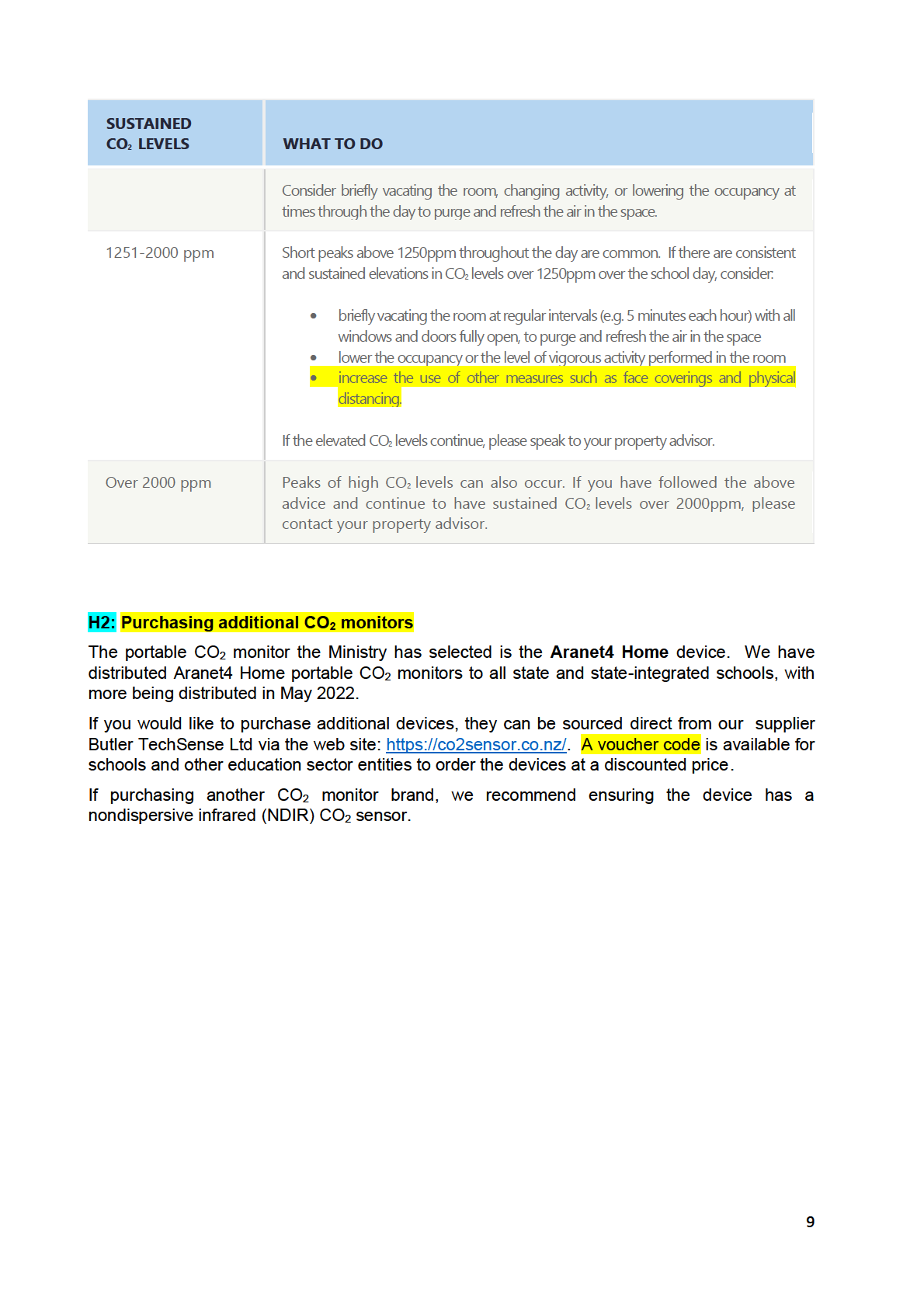
1982
Act
Information
Official
the
under
Released
L3 page: Ventilation resources
H1: Downloadable resources – winter advice
• A4 Poster: Promoting air flow in schools
• A4 Poster: Maintaining good ventilation in winter (new)
• Checklist: Pre-winter ventilation checks (new)
H1: Downloadable resources – other
•
1982
Diagram: The Ministry’s Ventilation Strategy (layered approach)
• A4 Poster: How different ventilation methods compare (new)
• A4 Poster: How to use a Samsung portable air cleaner
•
Act
A4 Poster: Where to position your portable air cleaner
• Technical Advice: Ducted mechanical ventilation systems
H1: Research and studies
H2: Classroom ventilation study (January 2022)
The results from our study with NIWA to understand more about classroom ventilation further
verified our COVID-19 classroom ventilation strategy.
The study involved looking at ventilation levels in typical classrooms being used as they normally
Information
are during the day. This was done by monitoring the amount of CO2, which indicates how much
fresh air flow there is, in 18 different classrooms across three schools.
The study verified that good ventilation can be achieved in most naturally ventilated classrooms
by opening windows and doors. The study highlighted the added benefits of opening windows
and doors on different sides of the room, of introducing short breaks to periodically purge the
room of stale air, and of supplementary assisted natural ventilation systems (e.g. extract/exhaust
Official
fans).
It also identified other areas for further research, including classroom ventilation in cold weather,
the
and the effective use of portable air cleaners and other supplementary measures.
• Paper: NIWA rapid study
[Placeholder here for subsequent study, 2x literature reviews, Nanogirl – add as/when available]
under
H1: Other online resources
Ministry of Education property advisors — education.govt.nz
Te Mahau – Advice for schools and kura
Unite against COVID-19 — covid19.govt.nz
Released
10

1982
Act
Information
Official
the
under
Released
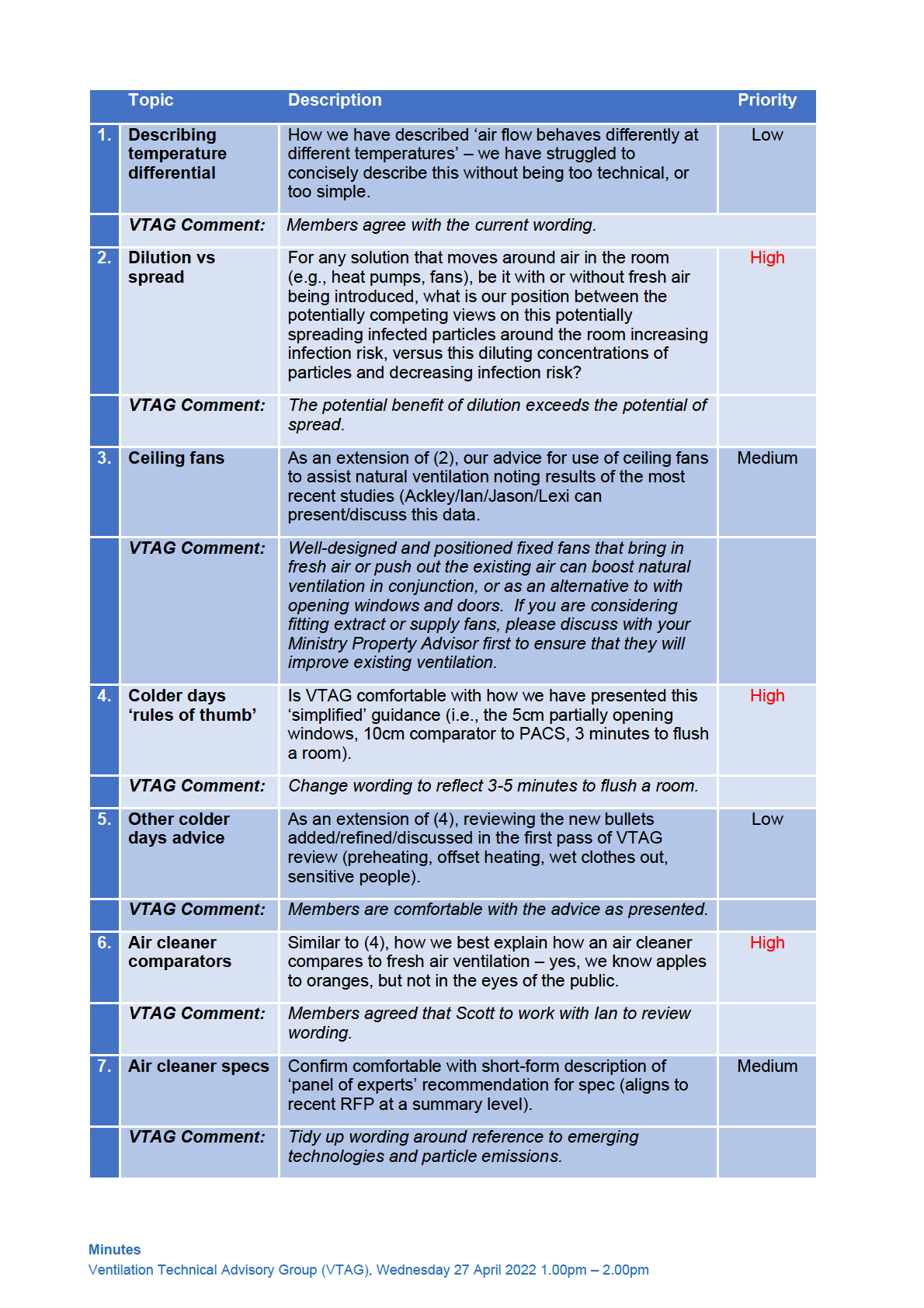
1982
Act
Information
Official
the
under
Released

1982
Act
Information
Official
the
under
Released
Action Log
Open items:
Action #
Action description
Due
Responsible
VTAG 0016 Renelle to discuss ventilation commentary in schools by
30/04/22
Renelle
Prof Baker with Robyn Phipps to understand his concerns.
1982
Recently closed items
Out of scope
Act
Information
Official
the
under
Released
Out of scope
Out of scope
1982
Act
Information
Official
the
under
Released
Minutes
Ventilation Technical Advisory Group (VTAG), Wednesday 27 April 2022 1.00pm – 2.00pm
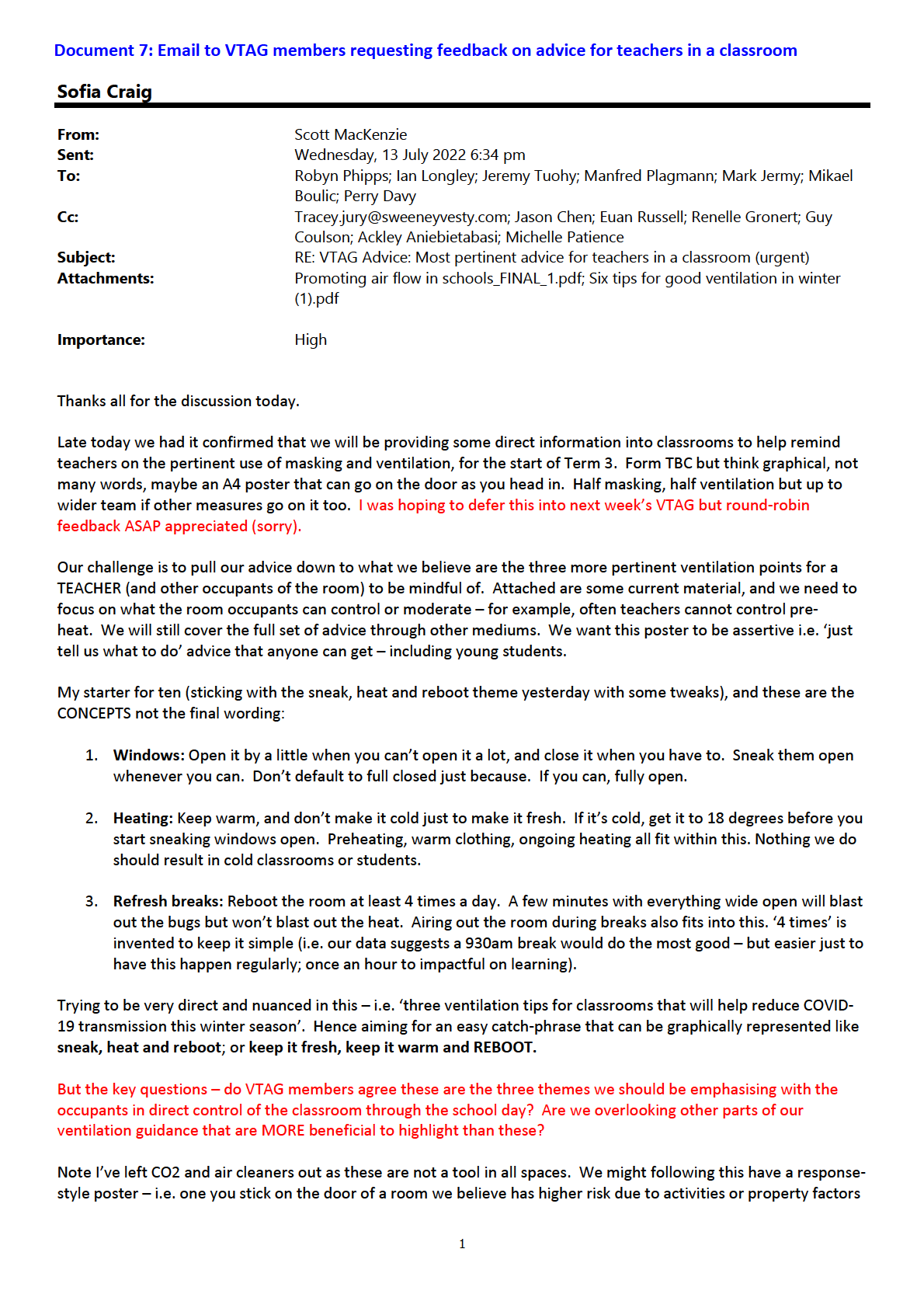
1982
Act
Information
Official
the
under
Released
that point to other more specific mitigations (i.e. This room has an air cleaner in it for a reason – turn it on FULL all
day!).
All ideas and feedback welcomed!
Thanks again,
Scott MacKenzie
Programme Director – Ventilation (COVID-19)
1982
Act
Information
Official
the
under
Released
2
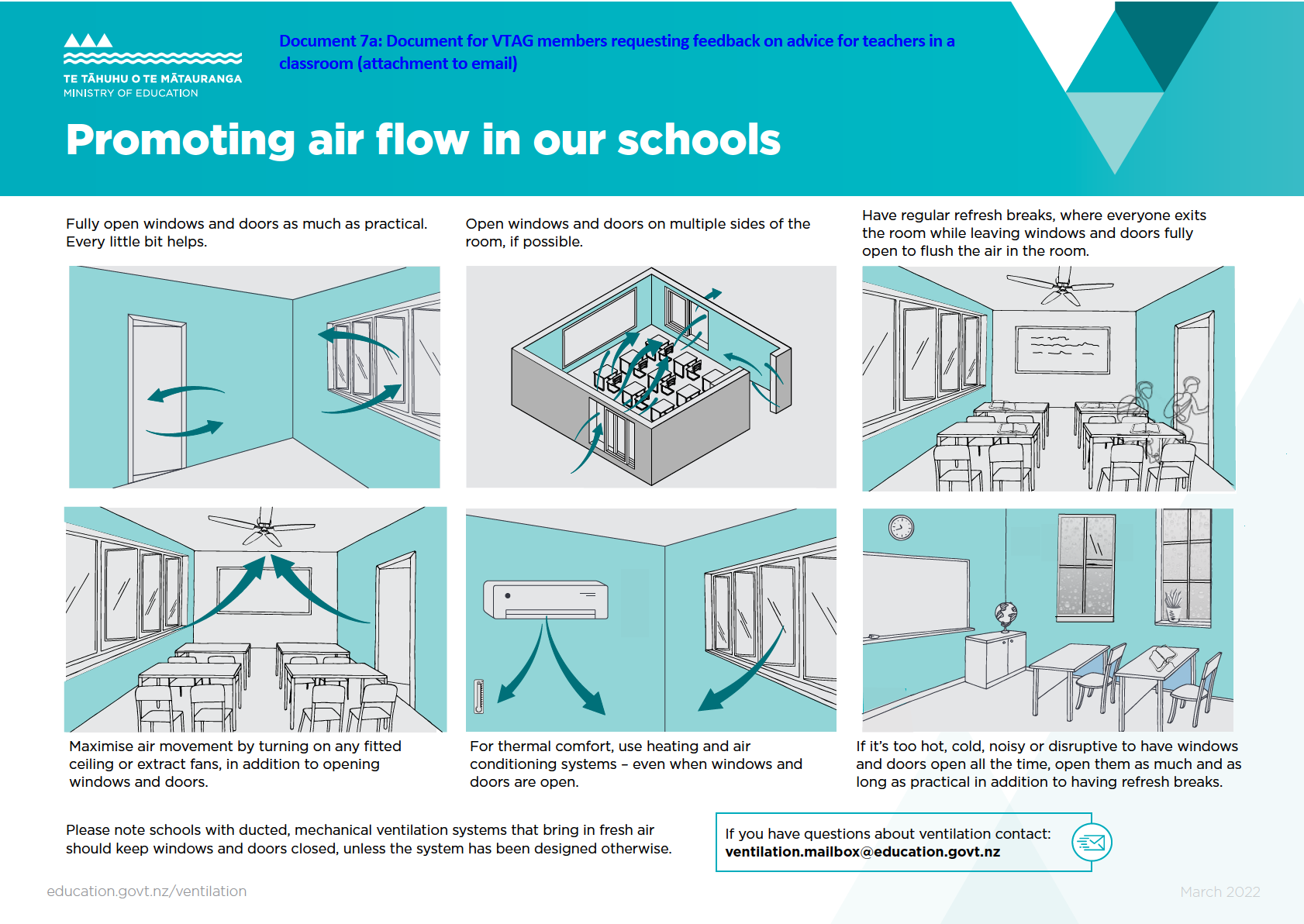
1982
Act
Information
Official
the
under
Released

1982
Act
Information
Official
the
under
Released

1982
Act
Information
Official
the
under
Released
heat. We will still cover the full set of advice through other mediums. We want this poster to be assertive i.e. ‘just
tell us what to do’ advice that anyone can get – including young students.
My starter for ten (sticking with the sneak, heat and reboot theme yesterday with some tweaks), and these are the
CONCEPTS not the final wording:
1. Windows: Open it by a little when you can’t open it a lot, and close it when you have to. Sneak them open
whenever you can. Don’t default to full closed just because. If you can, fully open.
2. Heating: Keep warm, and don’t make it cold just to make it fresh. If it’s cold, get it to 18 degrees before you
start sneaking windows open. Preheating, warm clothing, ongoing heating al fit within this. Nothing we do
should result in cold classrooms or students.
1982
3. Refresh breaks: Reboot the room at least 4 times a day. A few minutes with everything wide open will blast
out the bugs but won’t blast out the heat. Airing out the room during breaks also fits into this. ‘4 times’ is
invented to keep it simple (i.e. our data suggests a 930am break would do the most good – but easier just to
Act
have this happen regularly; once an hour to impactful on learning).
Trying to be very direct and nuanced in this – i.e. ‘three ventilation tips for classrooms that will help reduce COVID-
19 transmission this winter season’. Hence aiming for an easy catch-phrase that can be graphically represented like
sneak, heat and reboot; or keep it fresh, keep it warm and REBOOT.
But the key questions – do VTAG members agree these are the three themes we should be emphasising with the
occupants in direct control of the classroom through the school day? Are we overlooking other parts of our
ventilation guidance that are MORE beneficial to highlight than these?
Information
Note I’ve left CO2 and air cleaners out as these are not a tool in all spaces. We might following this have a response-
style poster – i.e. one you stick on the door of a room we believe has higher risk due to activities or property factors
that point to other more specific mitigations (i.e. This room has an air cleaner in it for a reason – turn it on FULL all
day!).
All ideas and feedback welcomed!
Official
Thanks again,
the
Scott MacKenzie
Programme Director – Ventilation (COVID-19)
under
Released
2
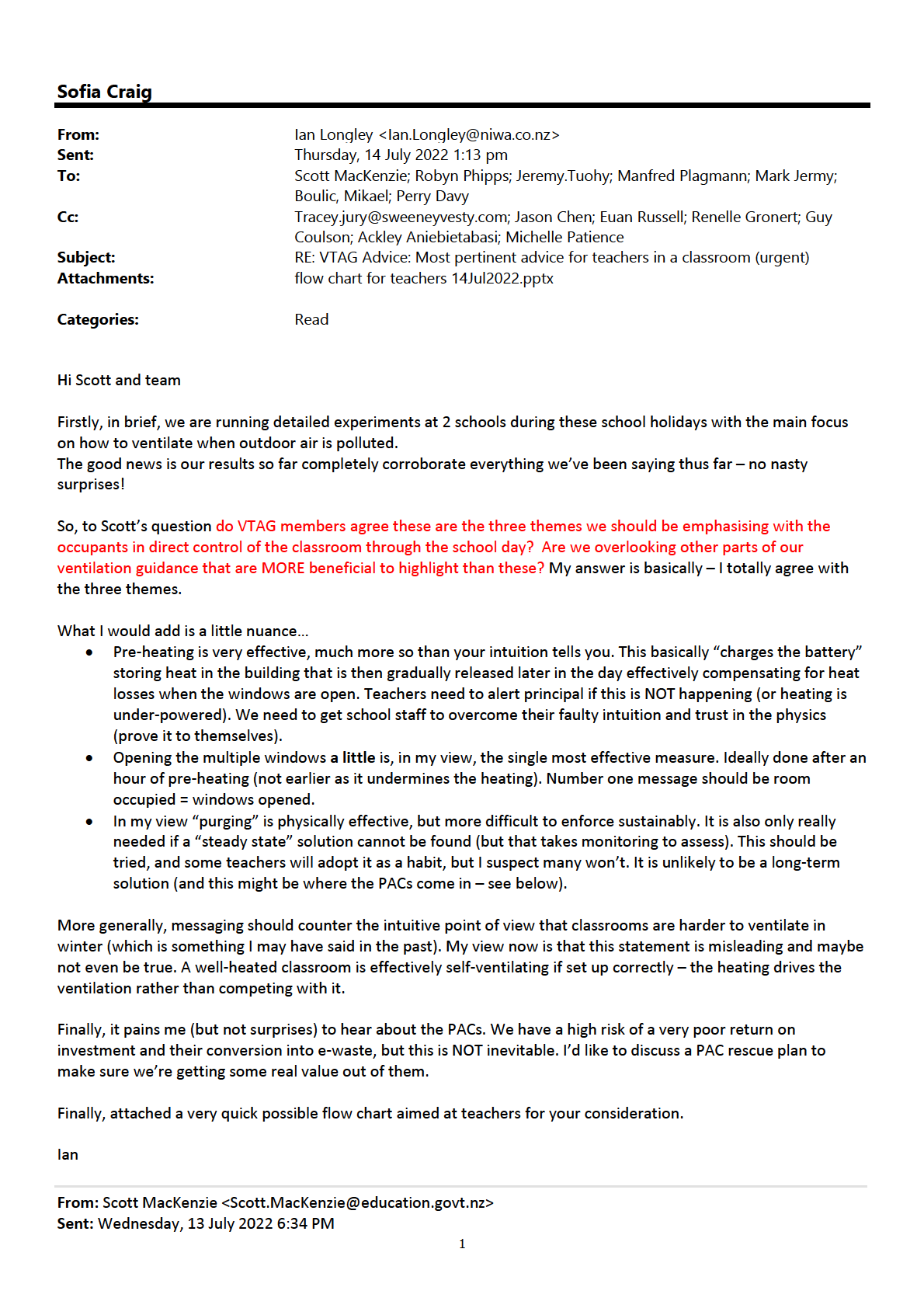
1982
Act
Information
Official
the
under
Released
To: Robyn Phipps <[email address]>; Ian Longley <[email address]>; Jeremy Tuohy
<[email address]>; Manfred Plagmann <[email address]>; Mark Jermy
<[email address]>; Boulic, Mikael <[email address]>; Perry Davy <[email address]>
Cc: [email address]; Jason Chen <[email address]>; Euan Russell
<[email address]>; Renelle Gronert <[email address]>; Guy Coulson
<[email address]>; Ackley Aniebietabasi <[email address]>; Michelle Patience
<[email address]>
Subject: RE: VTAG Advice: Most pertinent advice for teachers in a classroom (urgent)
Importance: High
Thanks all for the discussion today.
Late today we had it confirmed that we will be providing some direct information into classrooms to help remind
1982
teachers on the pertinent use of masking and ventilation, for the start of Term 3. Form TBC but think graphical, not
many words, maybe an A4 poster that can go on the door as you head in. Half masking, half ventilation but up to
wider team if other measures go on it too. I was hoping to defer this into next week’s VTAG but round-robin
Act
feedback ASAP appreciated (sorry).
Our challenge is to pull our advice down to what we believe are the three more pertinent ventilation points for a
TEACHER (and other occupants of the room) to be mindful of. Attached are some current material, and we need to
focus on what the room occupants can control or moderate – for example, often teachers cannot control pre-
heat. We will still cover the full set of advice through other mediums. We want this poster to be assertive i.e. ‘just
tell us what to do’ advice that anyone can get – including young students.
My starter for ten (sticking with the sneak, heat and reboot theme yesterday with some tweaks), and these are the
CONCEPTS not the final wording:
Information
1. Windows: Open it by a little when you can’t open it a lot, and close it when you have to. Sneak them open
whenever you can. Don’t default to full closed just because. If you can, fully open.
2. Heating: Keep warm, and don’t make it cold just to make it fresh. If it’s cold, get it to 18 degrees before you
start sneaking windows open. Preheating, warm clothing, ongoing heating al fit within this. Nothing we do
Official
should result in cold classrooms or students.
3. Refresh breaks: Reboot the room at least 4 times a day. A few minutes with everything wide open will blast
the
out the bugs but won’t blast out the heat. Airing out the room during breaks also fits into this. ‘4 times’ is
invented to keep it simple (i.e. our data suggests a 930am break would do the most good – but easier just to
have this happen regularly; once an hour to impactful on learning).
Trying to be very direct and nuanced in this – i.e. ‘three ventilation tips for classrooms that will help reduce COVID-
under
19 transmission this winter season’. Hence aiming for an easy catch-phrase that can be graphically represented like
sneak, heat and reboot; or keep it fresh, keep it warm and REBOOT.
But the key questions – do VTAG members agree these are the three themes we should be emphasising with the
occupants in direct control of the classroom through the school day? Are we overlooking other parts of our
ventilation guidance that are MORE beneficial to highlight than these?
Note I’ve left CO2 and air cleaners out as these are not a tool in all spaces. We might following this have a response-
style poster – i.e. one you stick on the door of a room we believe has higher risk due to activities or property factors
Released
that point to other more specific mitigations (i.e. This room has an air cleaner in it for a reason – turn it on FULL all
day!).
All ideas and feedback welcomed!
Thanks again,
2

Scott MacKenzie
Programme Director – Ventilation (COVID-19)
DISCLAIMER:
This email and any attachments may contain information that is confidential and subject to legal privilege. If you are not the intended recipient, any use,
dissemination, distribution or duplication of this email and attachments is prohibited. If you have received this email in error please notify the author immediately and
erase all copies of the email and attachments. The Ministry of Education accepts no responsibility for changes made to this message or attachments after transmission
from the Ministry.
Dr Ian Longley
Principal Scientist - Air Quality
Programme Leader - Atmospheric Environment, Health and Society
1982
9(2)(a)
M
m
m
National Institute of Water & Atmospheric Research Ltd (NIWA)
Act
41 Market Place Viaduct Harbour Auckland New Zealand
Connect with NIWA: niwa.co.nz Facebook LinkedIn Twitter Instagram
To ensure compliance with legal requirements and to maintain cyber security standards, NIWA's IT systems are subject to ongoing monitoring, activity
logging and auditing. This monitoring and auditing service may be provided by third parties. Such third parties can access information transmitted to,
processed by and stored on NIWA's IT systems
Information
Official
the
under
Released
3

1982
Act
Information
Official
the
under
Released
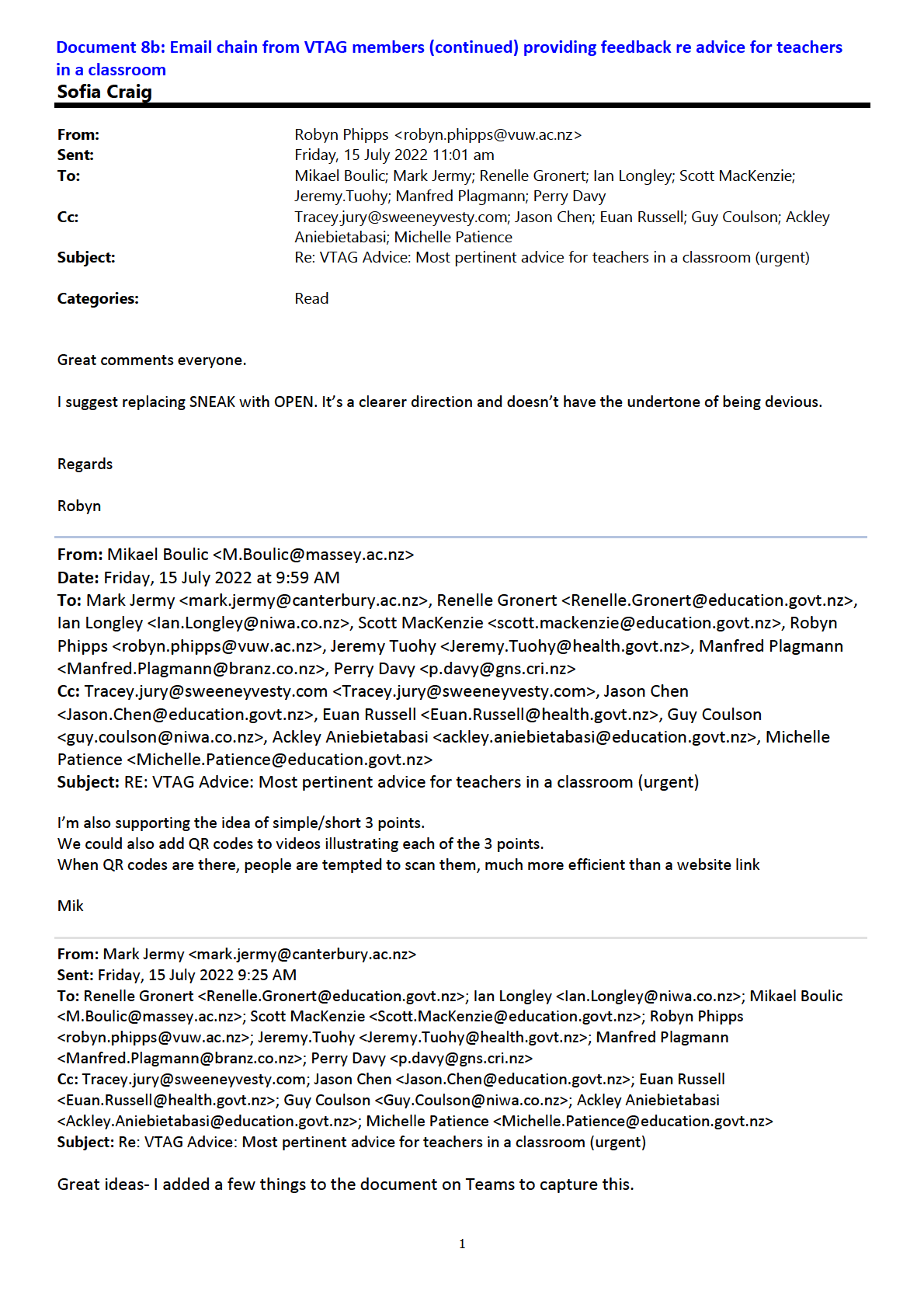
1982
Act
Information
Official
the
under
Released














































